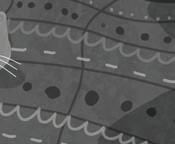


























Thanks to globalization and the emergence of technology, international boundaries have become blurred. English, to a high degree, is a commonly understood medium of communication throughout the world. It is also one of the key tools that students require to perform well. According to a global study, 98.5% of employers implicitly or explicitly assess a candidate’s English communication skills while recruiting them. There is, therefore, a growing demand for English communication skills, because it empowers people and enables them to lead a better life.
Early exposure to English is essential for children’s overall academic and personal growth. It not only facilitates effective communication but also lays the foundation for all future language learning. However, it is equally imperative to adhere to a scientific approach when introducing children to English or any second language during their foundational stages.
Highlighted by a wide range of research and also by the NEP 2020, a strong foundation in listening and speaking from an early age leads to better reading–writing skills as well as improved academic performance in the target language. In fact, special emphasis is placed on conversational and communication skills at the ECCE stage, in the NEP document. Along the same lines, the first 8 years in a child’s life are deemed critical, in the new NCF, for acquiring a language orally and which forms the basis of literacy and cognitive development.
Yet, English listening and speaking often tends to take a back seat during the early years in schools against the standard teaching practices around decoding, tracing and phonemic awareness activities. In order to address this humungous learning gap during the foundational years, Uolo has launched a powerful program for oral language development in English—Speak! It comprises two components—the Conversations book through which classroom interactions and teaching take place, and the Uolo App that houses all digital assets of the program.
Aligned with the spirit of NEP 2020 and NCF for foundational stages, Speak adheres to the communicative language approach, and gives precedence to developing listening and speaking skills in English in an anxiety-free, meaningful and fun-filled environment.
The program steers clear of teaching reading–writing and focuses exclusively on oral language development of children. The book follows a theme-based learning approach, where carefully curated themes become separate chapters and go on for a month. For example, food, seasons, good habits and body are few of the themes that are at once crucial yet easy for learners to begin their listening and speaking practice in. The focus in each theme is on giving an input-rich listening environment to children, with the help of joyous stories and poems, and developing the English vocabulary and oral expression around that theme in childfriendly ways. In order to develop speaking, the highly acclaimed ‘Total Physical Response’ (TPR) method is used, where repeated physical actions and gestures are used to learn words and expressions in English. Additionally, the book is technologically powered and works in sync with a parallel digital world which contains immersive animations of the stories and poems in the Conversations book for easy listening and viewing, anytime, anywhere! The digital world also enables fun-filled practice of key words, phrases and sentences in English. The accompanying teacher manual guides the classroom transactions in a step-bystep manner and makes the process of teaching–learning thoroughly enjoyable.
To sum it up, Speak is a unique blended program for developing usable English listening and speaking skills, at the foundational levels, in the most creative way possible. Within these colourful pages lie stories waiting to be heard, songs waiting to be sung, rhymes waiting to be danced to, a language waiting to be spoken, and dreams waiting to take flight. The book not only helps children master English speaking in a joyous manner, but also transports them to far-off lands, introduces them to fascinating characters, and ignites their imagination like nothing else can. So, let your children dive into the magic of learning the English language and emerge as confident English speakers.
Derived from global research, NEP 2020 and NCF
1.Communicative Language Teaching (CLT)
The focus is primarily on meaningful communication, effective expression of ideas and oral competence in the target language. Oral fluency and meaningful interaction takes precedence over perfect grammar and accuracy of vocabulary.
2.Theme-Based Learning
One theme or topic binds all the learning content and activities, and goes on for a longer period of time. It makes the learning process more meaningful and engaging for young learners.
3.Total Physical Response (TPR)
This method of language teaching is exceptionally valuable for young learners when they are learning a new or a second language. In this method, children use their bodies and movements to respond to language instructions given by the teacher. This tactile and interactive approach makes secondlanguage learning a lot of fun as children connect words with actions, helping them remember and use the language more effectively.
4.Holistic and Integrated Education
English learning is organically integrated with concepts of health, culture, science, environment, current affairs, socio-emotional learning and sports.
5.Supportive Environment for Second Language Acquisition
In order to master oral fluency in the English language, an anxiety-free and input-rich environment is created with the help of rich texts, fun activities and digital platforms.
6.21st-Century Skills
21st-century skills are addressed, like confident expression, critical thinking, problem solving and digital literacy.
“In the 21st century, language teaching must go beyond traditional approaches and must aim to enable students to use language skills in real-life contexts for a wide variety of purposes” (NEP, 2020).
According to Vygotsky and Krashen’s theory of second language teaching, language acquisition happens best when learners are engaged in purposeful and meaningful tasks in an anxiety-free, non-judgmental, communication-oriented, input-rich, supportive and stress-free environment, along with a lot of scaffolding practices. This approach to second-language teaching is also highlighted by the NIPUN Bharat Mission document and NEP, 2020.
In this context, the Conversations series, along with the learning activities designed in it, can play a crucial role in creating an input-rich environment, employing diverse avenues for speaking practice in a fear-free and non-judgemental setting, coupled with real-time feedback.
The book has been developed based on the ‘Total Physical Response’ (TPR) model—a teaching-and-learning approach that has been widely recommended by the NEP, 2020 and the NCF, 2022. It is a method of teaching language and vocabulary by using physical movement to go along with or react to verbal input. The TPR has been promoted by educational researchers and practitioners all over the world for its effectiveness in enhancing students’ language acquisition and promoting active engagement in the learning process.
The “I Do, We Do, You Do” model is a powerful instructional framework that scaffolds learning from the teacher to the students. By providing structured support and opportunities for guided practice, followed by independent application, this model promotes active engagement and empowers students to build confidence in the usage of the language.
I Do: The teacher demonstrates and models the new language concepts and vocabulary.
We Do: As the learners begin to grasp the concepts and vocabulary, the teacher and learners engage in a guided practice, together. This involves the teacher providing prompts, or sentences, and the students repeating, or echoing, them.
You Do: Finally, the learners attempt to apply the concepts or vocabulary they have learnt without direct guidance from the teacher. The learners are given the opportunity to independently express themselves and repeat language patterns or content without direct guidance from the teacher.
Based on this approach, there are three core instructional models on which the activities work. These are: I
Fully guided: modeled speaking by the teacher
Collaborative: shared speaking between the learners and the teacher
Independent practice: repetition of the language pattern or content by the learners
To sum it up, this has been created with a view to provide children with a fear-free environment to be exposed to and immersed in second-language acquisition from an early age.

Dear teachers,
We hope this letter finds you well and enthusiastic about the upcoming implementation of the Uolo Speak program in your classroom. We’re thrilled to introduce it, and it is all about nurturing your learners’ listening and speaking skills in English. We are excited to collaborate with you to enhance English language learning for your learners. This program is designed to foster English listening and speaking skills in a fun and engaging way, aligning with NEP 2020 and the NCF for Foundational Stage. We believe that your dedication and expertise will play a crucial role in the successful implementation of the program, and we are here to provide you with the necessary support and resources.
To assist you in effectively integrating the program into your curriculum, we have outlined some key points as given below:
Curriculum Alignment: The Speak program is designed to complement existing curricula, focusing on English language development through interactive activities and engaging content.


Program Components: The program consists of the Conversations book and the Uolo App, which together provide a comprehensive learning experience. The book contains colorful illustrations, and interesting stories and poems; while the app offers digital assets and interactive features.
Implementation Tips: We encourage you to explore the program’s resources and incorporate them into your teaching practices. Some suggestions include:
• Encouraging the learners to engage in dialogues about the visuals and the themes in the book.
• Reading the stories aloud, with expressions, and scanning the QR code to play their animated versions on the Uolo App.
• Knowing the learners’ thoughts and feelings about the key events in the story.
• Singing the poems together, with actions, and discussing the illustrations.
• Talking about the illustrations and scanning the QR code to play the animation of the poems on the Uolo App.
• Taking the support of home language, wherever needed, to explain the meaning of the texts or during conversations.

• Providing opportunities for learners to practise speaking and build oral fluency. Asking the learners to share some of the words and sentences, that they have learnt to speak in the class, on a regular basis, and helping them practise saying them with fluency and confidence. You can add a few words and sentences on your own as well.


• Using actions, like hand gestures and body movements, with key words, phrases and sentences to aid in meaning-making.
• Setting realistic and achievable class objectives by considering factors such as the learners’ attention span, language proficiency level at the beginning, English language input at home and overall classroom atmosphere.
• Breaking down larger language learning objectives into smaller chunks that can be accomplished within a single class period.
Collaborating with Parents: Parents play a crucial role in supporting their children’s language development. We have provided homeworks that would require parents’ participation in their children’s learning and help reinforce English at home. We encourage you to collaborate with them to ensure a cohesive English experience.
Continuous Support: Our team is always available to provide ongoing support and assistance as you implement the program. Whether you have questions, need additional resources, or want to share feedback, please don’t hesitate to reach out to us.
We are confident that with your dedication and our collaborative efforts, the Uolo Speak program will have a positive impact on your learners’ English language development. Thank you for your commitment in providing high-quality education, and we look forward to working together to support your success.
Warm Regards,
The Uolo Speak Team

In order to ensure that the learners are comfortable, active and engaged during the class, and to keep the surprise element going, you can try the following quick and easy games to keep the classroom fun and lively:
1. Bring a ball to the class. Then, sing / play a rhyme / poem. Instruct the learners to pass the ball to the student next to them. Take a surprise pause. The learner with the ball has to guide the class to follow their action. You can do this 3–4 times.
2. Play the game ‘I say’. You will say, ‘I say…’ and do some action words. The learners will copy them only if you say the phrase ‘I say’ before the action words. For example: Say, ‘I say clap your hands’ and the learners will clap their hands.
3. Include short movement breaks during the class to help students release energy and refocus. Activities like dancing to music, stretching, jumping or simple yoga poses can be great.
4. Call out different animals and have the children copy their sounds. For example, ‘Roar like a tiger,’ ‘Meow like a cat,’ or ‘Hiss like a snake.’ This activity encourages creativity thinking.
5. Play upbeat music and encourage the children to dance freely. When the music stops, they must freeze in place until the music starts again. This game helps improve listening skills, coordination and the ability to stop and start quickly.
6. Choose a learner to be the leader or you may become one. Then, have the rest of the learners follow their movements. The leader can perform actions like skipping, hopping, dancing or jumping.
7. Bring a sponge smiley ball to the class. Then, toss the ball to the learners. Those who get the ball will have to make a funny face and others will copy them.
8. In order to gain the attention of the class as a group, you may guide the learners with the instruction that whenever you use the phrase, ‘One, two, three ...’, they have to say, ‘Look at me!’ and look at you wherever you may be positioned in the class. This helps to establish a clear signal and reinforces the desired behaviour of paying attention.
9. The activity ‘Clap and Respond’ helps to bring the learners’ attention back to the class and work on their listening and sensory skills. You may clap a rhythm, and the learners respond to you by clapping the same rhythm back.
10. Introduce props or objects related to the lesson or activity to capture interest and engage participants. This could include items like colourful flash cards, puppets or themed objects that tie into the theme being discussed.


As a part of the theme, learners will:
• learn to talk about the things that they do daily.


• learn to say some keywords, phrases and sentences related to daily actions.













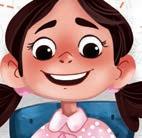
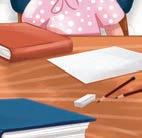

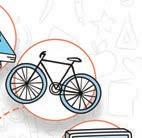

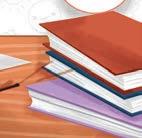





Say: listen My Daily Routine
Hello, children! Today, you will listen to the story—
You can use polite greetings like ‘Good Morning!’, ‘How are you?’, ‘How are you feeling today?’ or ‘What is your name?’ to begin the class.
Instruct:
Discuss pointing
Look at the picture on page no. 1 carefully. some of these suggested questions while pointing at the pictures.




Based on the learners’ responses, you may choose to ask a few follow-up questions on
You may give a chance to as many learners as possible to respond to your questions.


You may rephrase the learners’ responses into complete sentences and ask them to repeat those Yes, I like to eat a sandwich.

Say: My Daily Routine
You may choose to read play the Talking Book
Say:

Wonderful! Now, we will read a story called . It is about a boy named Kunal. He tells us what he does every day. Now, let us begin reading. the story aloud or . The first read is for the purpose of enjoyment and the second read is for the explanation of the story.
Now, I will tell you what the story means. Do not forget to point at the pictures while reading or explaining the story. Pause at regular intervals and explain the meaning in the learners’ home language, if required.



You may read the story with voice modulation, hand gestures and expressions to make it more

10 mins




Good morning! I am Kunal. I want to tell you about my day.
I wake up brush clean. After that, I eat learn
early in the morning. Then, I my teeth to keep them take a bath and get ready for school.


Before going to school, I my breakfast. Yummy! I feel so strong. At school, I play with my friends. I also to read and write.
I draw and colour too.


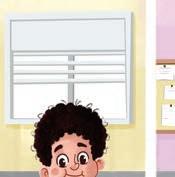











the meaning of the words and the phrases while reading the story. Associate the words and phrases with the suggested actions.

Sl. no.WordPronunciation

wake upwayk upto rise up from sleep
bruhsh

Sl. no. Word Pronunciation Meaning Action up wayk up to brush
act to stretch your hands and rub your eyes
act to brush your teeth using your index finger
take a bathtayk a baath to wash and clean oneself act to pour water on your head
to clean one’s teeth using a toothbrush take a bath tayk using soap and water eat eet to have food learn luhn to get to know about something drink to take water in the mouth and swallow play play to enjoy some sports or game sleep to go to bed


act to eat using your left hand as a plate
act to read or write dringk
You may pause at the annotations and ask these suggested questions.



act to drink water showing a glass in a hand
act to hit an imaginary ball with an imaginary bat sleep
act to sleep by resting your head on your hands

What does Kunal do in the morning?
(Kunal brushes his teeth in the morning. / Kunal takes a bath in the morning.)
What does Kunal do at school?
After Kunal
After
What does Kunal do after coming home from school?
(Kunal eats lunch. / Kunal sleeps. / Kunal listens to rhymes.)

What does Kunal do at night?
(Kunal eats his dinner. / Kunal sleeps at night.)




(Kunal learns at school. / Kunal reads at school. / Kunal draws and colours at school.)

Refer to the next page for annotations 3 and 4.
In the story, we read about Kunal and what he does every day.





Then, I come back home. I eat lunch and I sleep. When some milk. I listen to funny rhymes.





with my friends. After that, I come home and clean myself up. Then, my mother and I read stories together from colourful books.
At night, I eat dinner with my family. We share stories and jokes. After dinner, I brush my teeth. I say “Goodnight!” to everyone and go
The next day, I follow the same routine.
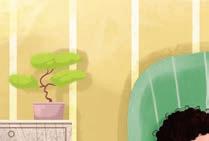

In the evening, I go to play sleep •

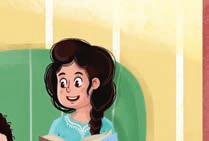









Today is Sunday!

What a fun day!


It is a holiday!

I will wake up late, And eat on the bed.



Breakfast on the plate!

Yummy! Milk and bread.
I will watch a cartoon show. I will play with clay.
To the garden, I will go, And enjoy all day.
When I come back home, I will eat and rest.
I will bathe in foam, Sundays are the best.

















Say: My Daily Routine. It was about
Hello, children! In the last class, we heard a story called a boy called Kunal. We heard what he does every day. We also learnt the words ‘brush’, ‘sleep’ and ‘learn’; and the phrase ‘take a bath’.
You can use one of the activities given in the front matter to grab the attention of the learners and to


Say:
Instruct: Let us start.
Discuss





Let us have some fun! I will do some actions and you will say what I am doing. the keywords learnt in the previous class.



You may rephrase the learners’ responses into complete sentences and ask them to repeat those I brush my teeth.
Wonderful! That was fun.
Who do you see in this picture?
(I see a boy.)
2. What is the boy doing? playing
(The boy is eating. / The boy is playing with the football.)
3. What is the boy eating? (He is eating bread.)
4. Where is the boy playing? (He is playing in the park.)


Now, look at the pictures on page no. 4 carefully. some of these suggested questions while pointing at the pictures.
• My Routine


Based on the learners’ responses, you may choose to ask a few follow-up questions on






Say: We will read a rhyme called You may choose to read play the Talking Book for
Today is Sunday. It is about a boy who tells us what he does on a Sunday. Now, let us begin reading. the rhyme aloud or
. The first read is for the purpose of enjoyment and the second read is for the explanation of the rhyme.
Say:
Now, I will tell you what the rhyme means.


Do not forget to point at the pictures while reading or explaining the rhyme. Pause at regular intervals / after each sentence and explain the meaning in the learners’ home language, if required. the meaning of the words and the phrase while reading the rhyme. Associate the
Explain words with the suggested actions.
10 mins

You may read the rhyme with voice modulation, hand gestures and in rhythm to make it interesting for the learners.
Sl. no. Word Pronunciation Meaning


Sl. no.WordPronunciationMeaning Action


wake upwayk-upto rise up from sleep act to stretch your hands and rub your eyes to have food act to eat using your left hand as a plate to see something act to point at your eyes and then at an playplay to enjoy some sport or game act to hit an imaginary ball with an imaginary bat to sit or lie downsit on a chair to wash and clean using soap and water act to rub your right arm with your left palm
You may pause at the annotations and ask these suggested questions.
(It is Sunday. / It is a fun day. / It is a holiday.)
(‘I’ will wake up late. / ‘I’ will eat bread and milk.)
1 up wayk-up to eat eet watch woch object play play rest rest down sit bathe bayth up and down bath.)

Refer to the previous page for annotations.

Where will ‘I’ go to play? (‘I’ will go to the garden to play.)
What will ‘I’ do when ‘I’ gets home after

(‘I’ will eat lunch. / ‘I’ will rest./ ‘I’ will take a


If the learners respond correctly, you may rephrase their responses into complete sentences and ask them to repeat the sentences. For example: If a learner says ‘eat’, you could rephrase it to, ‘“I” will eat’.
Summarise
Say:

In this rhyme, we read about the fun things that we do on a Sunday.







In Richa’s room, Night and day, The Talking Clock talks. But what does she say?
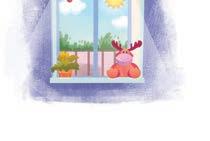
“Good morning, It’s time.”

“Goodmorning, Richa! breakfast

Says the Talking Clock, In a musical rhyme.




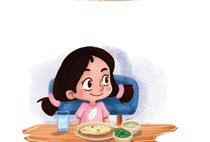
“Goodafternoon, Richa! Here is your plate. lunch It will not wait!”

“Good afternoon, The is ready, dinner.

“Good evening, Richa! Get ready for It’s night time, One should sleep sooner.”








Say: . It was
Hello, children! In the last class, we heard a rhyme called Today is Sunday about a boy who wakes up late, eats food, plays and watches TV on a Sunday. We also learnt the new action phrase ‘wake up’ and words ‘eat’, ‘watch’ and ‘play’.
You may include some exercises or actions, during the class, to keep the learners active and engaged.
Say:
Instruct: Let us start.
Discuss




Let us have some fun! I will do some actions and you will say what I am doing. the keywords learnt in the previous class.





You may rephrase the learners’ responses into complete sentences and ask them to repeat those I wake up early.
Wonderful! That was fun.


Now, look at the pictures on page no. 5 carefully. some of these suggested questions while pointing at the pictures.
What do you see in this picture?
(I see a girl / a sandwich / a window.)
2. What is the girl doing? (She is eating a sandwich.)
3. (It is morning.)
Look at the first window. Is it morning or night?


4. the
When do you eat your food during the day?
(I eat my food in the morning, afternoon and at night.)




Based on the learners’ responses, you may choose to ask a few follow-up questions on







Say: We will read a rhyme called . It is about a girl, Richa. There is a You may choose to read play the Talking Book. The first read is for
The Talking Clock talking clock in her room. Now, let us begin reading. the rhyme aloud or the purpose of enjoyment and the second read is for the explanation of the rhyme.

You may read the rhyme with voice modulation, hand gestures and in rhythm to make it interesting for the learners.
Say:

Now, I will tell you what the rhyme means. required.
Do not forget to point to the pictures while reading or explaining the rhyme. Pause at regular intervals / after each sentence and explain the meaning in the learners’ home language, if required.
the meaning of the words while reading the rhyme.


Explain day when sun rises when sun sets what we eat in the morning what we eat in the afternoon what we eat at night

1
What is there in Richa’s room?
(There is a ticking clock.)
After 2
What does Richa eat in the morning? (She eats breakfast.)

You may pause at the annotations and ask these suggested questions.
After 3
What does she eat in the afternoon? (She eats lunch.)
After 4


What does she eat at night? (She eats dinner.)
Sl. no. Word Pronunciation Meaning day night nite breakfast brek.fuhst lunch luhnch dinner din.uh She eats dinner.
Summarise


You may rephrase the learners’ responses into complete sentences and ask them to repeat those sentences with you. For example:







Say: In this rhyme, we read about the things that Richa will do in the morning, in the afternoon, and at night.





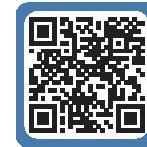
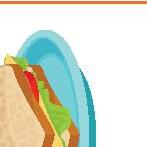




I play in the park. I sleep at night. I eat breakfast in the morning.




I watch TV. I eat lunch in the afternoon. I eat dinner at night.



My Routine
























Discuss

the keywords and the phrases learnt in periods 1, 2 and 3.
1. Instruct:
Say what I say. Do what I do.
brush my teeth.
action
your index finger. I brush
Do the action of brushing your teeth using my teeth in the morning.
Repeat 5–6 times.
2. Instruct:
Say what I say. Do what I do.
I eat lunch in the afternoon.


Do the action of tapping your watch. I eat lunch at school.
Repeat 5–6 times.
3. Instruct:
Say what I say. Do what I do.
watch TV.
object. I watch a cartoon show.
Repeat 5–6 times.
Repeat

Do the action of pointing at your eyes and then to an the process for all the keywords and phrases.
Now, I will call you, one by one, so that you can speak the sentences for the words and phrases related to the things and actions that we do daily.
Invite as many learners as possible to say the sentences.

Say: words and as
Instruct: Tell me the sentence with the word ‘lunch’. Repeat the process for all the keywords and phrases. E & R



You may use the actions while speaking the words so that the learners are able to associate and recall the sentences or phrases learnt for the words.
You may praise the learners if they share sentences other than those discussed in the class.
You may praise the learners for speaking confidently and correctly. You may say ‘Very good!’, ‘Well done!’ or ‘Fantastic!’. If the learners hesitate, you may prompt them or guide them through actions.







What is your daily routine? Number the pictures 1 to 6 in
the right order.



























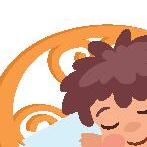










Say:
Now, turn to page no. 8 of your book.
Explain:
There are pictures of the actions that we do daily. You have to number the pictures from 1 to 6, in the order that you do these activities. For example: First, I wake up in the morning, so I will number it 1.
morning,
Now, you have to number the pictures. Write the numbers in the boxes given. You may ask these suggested questions.


Instruct: wake (I brush my teeth.)

What do you do after you wake up?

2. (I take a bath.)
What do you do before getting ready for school?
3. What do you do at school? (I learn at school.)
4. What do you do in the park? (I play in the park.)



What do you do at night? (I sleep at night.) daily actions.






Say: In this chapter, we learnt to speak words, phrases and sentences related to our







As a part of the theme, learners will: • learn to talk about fruits and vegetables. learn to say some keywords, phrases and sentences related to fruits and vegetables.



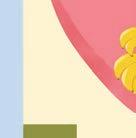
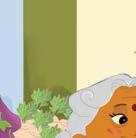

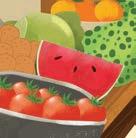
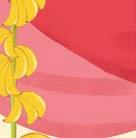










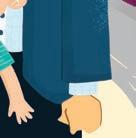


Say:



Good morning, children! Today, you will listen to the story—The Kitchen Garden
You can use polite greetings like ‘Good morning!’, ‘How are you?’, ‘How are you feeling today?’ or theme-based question like, ‘What did you eat for breakfast today?’ to begin the class.
Instruct:
Discuss pointing
Look at the picture on page no. 9 carefully. some of these suggested questions while pointing at the pictures.



What do you see in the picture?
2. Do you like to eat fruit?
3.
(Yes, I like to eat fruit. / No, I do not like to eat fruit.)
Do you go to the market with your parents?
(Yes, I go to the market. / No, I do not go to the market.)

(I see a market. / I see people in the market. / I see fruits and vegetables.)
4. Which is your favourite fruit?
(My favourite fruit is mango / apple / banana / grapes.)

Which is your favourite vegetable?
(My favourite vegetable is carrot / potato.)



Based on the learners’ responses, you may choose to ask a few follow-up questions on the cover page.

In case the learners say the names of the fruits or vegetables in their home language, you can tell


You may rephrase the learners’ responses into complete sentences and ask them to repeat those sentences after you. For example: I see people in the market.

Say: Very good! Now, we will read a story called named Gappu. We will read about the vegetables that grow in Gappu’s kitchen garden. Now, let us begin reading.
You may choose to play purpose of enjoyment and the second read is for the explanation of the story.
Say: Now, I will tell you what the story means.

The Kitchen Garden. It is about a boy read the story aloud or the Talking Book. The first read is for the
Do not forget to point at the pictures while reading or explaining the story. Pause at regular intervals and explain the meaning in the learners’ home language, if required.
You may read the story with proper pauses, voice modulation, actions and expressions to make it more interesting for the learners.



10 mins




Gappu is sad. He does not like his new house.



Gappu misses his old house. He thinks about his big garden. He and
misses watering the tomato lemon plants.
Gappu is in his room. He hears his father call him. “Gapppuuuuuuuu! Please come here.”














the meaning of the words while reading the story.

You may bring the fruit and vegetables or flash cards of these words to help the learners understand no. Word Pronunciation

Sl. no.WordPronunciation Meaning
tomato tuh. .toh a lemon leh.muhn a carrots ka.ruhts vegetables

may.toha fruit that is red and round and is eaten as salad


.muhna fruit that is small, yellow and round
spinach spi.nuhch a kitchen garden ki gaa.dn a

.ruhtsvegetables that are red or orange and long
.nuhcha vegetable that is green and looks like a leaf
.chn .dna place where we grow fruit and vegetables for the kitchen
You may pause at the annotations and ask these suggested questions.
What does Gappu not like?


(Gappu does not like his new house.)
After
Which plants did Gappu water at his old house?
(Gappu watered tomato and lemon plants at his old house.)
Which plants grow in Gappu’s garden?



(The plants that grow in Gappu’s garden are curry, mint, chillies, brinjal, carrots and

What will Gappu help to grow in his new kitchen garden?
(Gappu will help to grow many vegetables in his new kitchen garden.)
Refer to the next page for annotations 3 and 4.
Summarise




In the story, we read about Gappu. We read how he misses his old garden. We also read how his mother, father and grandmother have made him a new kitchen garden.





in joy!
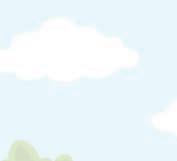


carrots and spinach.



He sees a beautiful garden! There are so many plants—curry and mint, chillies and brinjal,

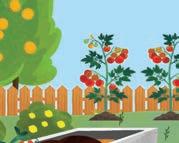



“This is your new kitchen garden, Gappu. You can help grow many vegetables here”, said his grandmother. Gappu is happy.










Explain

the meanings of these keywords in the learners’ home language.
1. Instruct: Say what I say. are red.
I eat tomatoes.
Repeat 5–6 times.
2. Instruct: Say what I say.
Lemons are yellow.
Lemons are small.
Repeat 5–6 times.
3. Instruct: Say what I say. are orange.
I like to eat carrots
Repeat 5–6 times.
4. Instruct: Say what I say.


is a green vegetable.
I like to eat spinach
Repeat 5–6 times.







Ask learners,
the learners, whom you may select randomly, to speak the sentences independently.
Instruct:
Repeat
Say: Now, you will tell me the sentences with these keywords. Tell me the sentence with the word ‘tomatoes’. the process for all the keywords.


You may ask the learners to say the colour and shape of the vegetables when they make sentences with them. For example: ‘Carrots are long.’ or ‘Lemons are yellow.’
Conclusion
Say:
Homework
Say: Today, you will tell your parents about the names of fruits and vegetables that you learnt in the class. You will also tell them the colour of the fruits and vegetables. You will tell them about the words ‘tomatoes’, ‘lemons’, ‘carrots’ and ‘spinach’. You may also show them the vegetables in your kitchen.
Theme 2
• Fruits and Vegetables



Today, we learnt to speak words and sentences on fruits and vegetables. We learnt to speak the words ‘tomatoes’, ‘lemons’, ‘carrots’ and ‘spinach’; and use them in sentences.




In a fruity land, where all fruits grow, The fruits put on a funny show.












Apples tell jokes, wear hats, Grapes

Oranges
bananas are busy with their chats.


and guavas dance on a beat,
Pineapples party all over the street.

Watermelons and mangoes race so fast,



In the fruity land, we all have a blast! 12







Say: . It was
Hello, children! In the last class, we heard a story called The Kitchen Garden about a boy called Gappu. We heard the names of the fruits and vegetables that grow in his kitchen garden. We also learnt the words ‘tomatoes’, ‘lemons’, ‘carrots’ and ‘spinach’.
You can use one of the activities given in the front matter to grab the attention of the learners and to


Say:
and you have to name them.
Instruct: Let us start.
Discuss





Let us have some fun! I will say the colour and shape of some fruits and vegetables the keywords learnt in the previous class.





You may rephrase the learners’ responses into complete sentences and ask them to repeat those sentences. For example: Tomatoes are round and red.
Say:
Lovely! That was fun.
Instruct: Now, look at the pictures on page no. 12 carefully. Discuss some of these suggested questions while pointing at the pictures.
(I see an apple and a banana.)
2. How many grapes are there?
(There are 8 grapes.)
Which fruits can you see in the first picture?
3. favourite
4. Which fruit is red and green?

Look at the pictures and tell me which is your favourite fruit. (Mango is my favourite fruit. / Apple is my favourite fruit.)
(Watermelon is red and green.)

Theme 2
• Fruits and Vegetables

Based on the learners’ responses, you may choose to ask a few follow-up questions on the illustrations.







Say: We will read a rhyme called Now, let us begin reading.
The Fruity Land. It is about different fruits that we eat.
You may choose to read play the Talking Book for
Say:
Now, I will tell you what the rhyme means.

the rhyme aloud or . The first read is for the purpose of enjoyment and the second read is for the explanation of the rhyme.
Do not forget to point at the pictures while reading or explaining the rhyme. Pause at regular intervals / after each sentence and explain the meaning in the learners’ home language, if required. the meaning of the words while reading the rhyme.
10 mins

Explain no. Word Pronunciation Meaning

You may read the rhyme with voice modulation, actions and in tune to make it interesting for the learners.

Sl. no.WordPronunciation

1 apples a.plz fruit that are round, red and sweet bananas buh.naa.naaz fruit
grapes grayps
.naazfruit that are long and yellow fruit that come in bunches and are small and green
oranges aw.ruhnj.uhz fruit that are round and orange
mangoes mang.goze fruit

.gozefruit that are oval, yellow or green and very sweet
guavas gvaa.vuhz fruit that are green and round watermelons vaw.tuh.meh.luhnz fruit

.tuh.meh.luhnzfruit that are green outside and red inside
You may bring the fruits or flash cards of the fruits to help the learners understand these words. You may also tell them which fruits need to be peeled before eating.


Note: Refer to the previous page for annotations.

You may pause at the annotations and ask these suggested questions.
Which fruits dance on a beat? (Oranges and guavas dance on a beat.)
Which fruits race so fast? (Watermelons and mangoes race so fast.)
If the learners respond correctly, you may rephrase their responses into complete sentences and ask them to repeat the sentences. For example: If a learner says ‘bananas’, you could rephrase it to ‘Bananas wear hats’.
Summarise



Say: In this rhyme, we read about different fruit that we eat. Fruits are healthy and sweet.




Explain

the meanings of these keywords in the learners’ home language.
1. Instruct: Say what I say. are sweet.
I eat apples. Repeat 5–6 times.
2. Instruct: Say what I say.
are healthy.



I like to eat bananas. Repeat 5–6 times.
3. Instruct: Say what I say. are tasty.
Grapes are small.
Repeat 5–6 times.
4. Instruct: Say what I say. are round.
Oranges are juicy.
Repeat 5–6 times.






If the learners struggle to repeat the sentences, you may ignore the articles and prepositions in the sentences. For example: I like eat bananas. You may avoid this strategy if you feel that the learners are getting proficient in their English speaking.
Ask
Say: Instruct: Tell Repeat

the learners, whom you may select randomly, to speak the sentences independently. Now, you will tell me the sentences with these keywords. Tell me the sentence with the word ‘apples’. the process for all the keywords.



If time permits, you may also invite the learners to speak the sentences with the words learnt in period 1—‘tomatoes’, ‘lemons’, ‘carrots’ and ‘spinach’.
Conclusion
Today, we learnt to speak the names of the fruit. We talked about how all of them grow in the fruity land. We learnt to say the words ‘apples’, ‘bananas’, ‘grapes’ and ‘oranges’; and use them in sentences.
Homework
Say: Say: about E & R
Today, you will tell your parents about the names of the fruits learnt in the class and tell their colours or shapes. You will tell them about the words ‘apples’, ‘bananas’, ‘grapes’ and ‘oranges’. You can show the pictures of the fruits in the book.
Theme 2
• Fruits and Vegetables









Let’s all sing The Vegetable Song, Veggies are both short and long!
Spinach is green,
Eat your veggies clean.

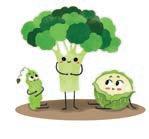





I like potatoes
Ginger-garlic add flavours bold, , hot or cold. and corn make a salad wow! Green leafy vegetables—eat them now.



When Dad chops onions, he always cries, But in hot oil, they are tasty fries.
From the earth, they brightly spring, Veggies, veggies, let’s all sing!
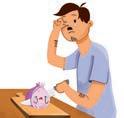



Cucumber •










Hello, children! In the last class, we heard a rhyme called The Fruity Land different fruits that we eat. We also learnt the new words ‘apples’, ‘bananas’, ‘grapes’ and
Say: . It was about ‘oranges’.
You may make the learners stretch or jump in between to draw their attention.
Say:
Let us have some fun! I will say the colour and shape of some fruits and you have to name them.
Instruct: Let us start.
Discuss


the keywords learnt in the previous class.


Nice! That was fun!





You may prompt and motivate the learners to speak the complete sentences learnt in the previous
2.
3.
Now, look at the pictures on page no. 13 carefully. some of these suggested questions while pointing at the pictures.

Look at the first picture carefully. Name the vegetable that is yellow in colour.
(Corn is yellow.)

Do you like to eat vegetables?
(Yes, I like to eat vegetables./ No, I do not like to eat vegetables.)
Look at the pictures and tell which is your favourite vegetable. (My favourite vegetable is cucumber. / My favourite vegetable is potato.)

4. (Onions make me cry.)

What vegetable makes you cry?



Based on the learners’ responses, you may choose to ask a few follow-up questions on
• Fruits and Vegetables








Say: We will read a rhyme called . It is about different vegetables that we eat. Now let us begin reading.
You may choose to read play the Talking Book. The first read is for
the rhyme aloud or the purpose of enjoyment and the second read is for the explanation of the rhyme.

You may read the rhyme with voice modulation, hand gestures and in rhythm to make it interesting for the learners.
Say:
Now, I will tell you what the rhyme means. required.
Do not forget to point at the pictures while reading or explaining the rhyme. Pause at regular intervals / after each sentence and explain the meaning in the learners’ home language, if required.

Explain the meaning of the words while reading the rhyme. Associate the words with the flash cards or real vegetables.

Sl. no. Word Pronunciation Meaning

spinach spi.nuhch
1 potatoes puh.tay.towz vegetables
kyoo.kuhm.buh a uh.nynz leafy leef.ee

1
Are veggies long?
(Yes, veggies are long.)
2
How should we eat our veggies? (We should eat our veggies clean.)
After


a vegetable that is green and looks like a leaf .towzvegetables that are round and brown .kuhm.buha vegetable that is green and long vegetables that are pink / purple and round something that looks like a leaf
You may pause at the annotations and ask these suggested questions.
3
Do you like potatoes? Which is your favourite potato dish?
4

What are tasty fries in hot oil?
(Onions are tasty fries in hot oil.)
Note: Refer to the previous page for annotations.







(Yes, I like potatoes. My favourite dish is French fries / aloo paratha. / No, I do not like potatoes.)


You may rephrase the learners’ responses into complete sentences and ask them to repeat those sentences with you. For example: We should eat our veggies clean.
Summarise
Say: In this rhyme, we read about different vegetables that we eat. We learnt that we should eat our vegetables clean.





Explain

the meanings of these keywords in the learners’ home language.
1. Instruct: Say what I say. are brown.
I like to eat potatoes
Repeat 5–6 times.
2. Instruct: Say what I say.
I eat cucumber



A cucumber is long.
Repeat 5–6 times.
3. Instruct: Say what I say. make me cry.
Onions are purple.
Repeat 5–6 times.
4. Instruct: Say what I say. mangoes
Mangoes are yellow.
Repeat 5–6 times.






Ask
the learners, whom you may select randomly, to speak the sentences independently.
Instruct:
Repeat
Say: Now, you will tell me the sentences with these keywords. Tell me the sentence with the word ‘mangoes’. the process for all the keywords.



Conclusion
Say:
Today, we learnt to speak the names of the vegetables and a fruit. We learnt to say the words ‘potatoes’, ‘cucumber’, ‘onions’ and ‘mangoes’ and use them in sentences.
Homework
Say: Today, you will tell your parents about the names of the vegetables and fruit learnt in the class and tell them their colour or shape. You will tell them about the words ‘mangoes’, ‘potatoes’, ‘cucumber’ and ‘onions’. You may also ask your parents which their favourite vegetable and fruit is.
Theme 2
• Fruits and Vegetables





































Discuss

the keywords and phrases learnt in periods 1, 2 and 3.
1. Instruct: Say what I say. are brown.
I like to eat potatoes
Repeat 5–6 times.
2. Instruct: Say what I say.
Bananas are healthy.
I like to eat bananas. Repeat 5–6 times.
3. Instruct: Say what I say. are red.





I eat tomatoes.
Repeat 5–6 times.
4. Instruct: Say what I say. mangoes.
Mangoes are yellow.
Repeat 5–6 times.
Repeat
the process for all the words.

Say: words related to fruits and vegetables.
Invite as
Instruct: Tell

Now, I will call you, one by one, so that you can speak the sentences for the words

as many learners as possible to say the sentences. Tell me the sentence with the word ‘mangoes’. the process for all the keywords.


If the learners struggle to speak the sentences, you may point at the objects with similar colours or shapes so that the learners can associate and recall the sentences or phrases learnt for the words. Theme
Repeat E & R •
























































Say:
Now, turn to page no. 16 of your book.
Explain:
There are some coloured pictures of fruits and vegetables. There are some pictures without colours. You have to colour the fruit or vegetable that looks the same as the coloured picture. For example: The first picture shows a tomato. The last picture in this row shows a tomato. So, we will colour it.
Instruct:
Now, you will colour the pictures that look the same. You may ask these suggested questions.

2.
Which fruit is round and red?
(A tomato is round and red.)

Which fruit is round and orange? Where is the orange in the row?
(An orange is round and orange. It is first in the row.)
3. is
Do you like mangoes? Where is the mango in the row?
(Yes, I like mangoes. It is number three in the row.)

What is the colour of the carrot?
4. carrot?
The carrot is orange.)
Say:



In this chapter, we learnt to speak words, phrases and sentences related to different fruits and vegetables.







As a part of the theme, learners will:
• learn to talk about different modes of transport.


• learn to say some keywords, phrases and sentences related to modes of transport.





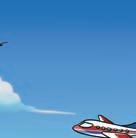
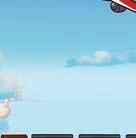
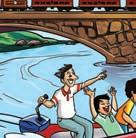
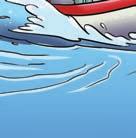



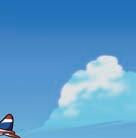

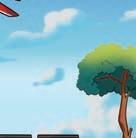
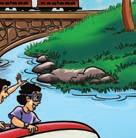




Say: listen


Hello, children! Today, you will listen to the story—Ragini’s Trip to the Village
You can use polite greetings like ‘It is good to see you all’ or ‘It is lovely to see your smiling faces’ or ask theme-based question like ‘Who likes to go on a trip?’ to begin the class.
Instruct:
Discuss pointing
Look at the picture on page no. 17 carefully. some of these suggested questions while pointing at the pictures.


What do you see in the water?
(I see a boat. / I see a boat with people in it.)
2. Have you sat in a boat?
(Yes, I sat in a boat when I went boating. / No, I have not sat in a boat.)
3. What do you see in the sky? (I see an aeroplane.)
4.
What other things do you see in the picture?

(I see a train. / I see clouds and trees. / I see some children. / I see birds.)
Based on the learners’ responses, you may choose to ask a few follow-up questions on the


You may ask some learners whether they have sat in the modes of transport shown in the pictures. You may give a chance to as many learners as possible to respond to your questions.
You may rephrase the learners’ responses into complete sentences and ask them to repeat those I see an aeroplane.

Say: Ragini’s Trip to the Village
begin reading.
You may choose to read play the Talking Book

Great! Now, we will read a story called . It is about a girl named Ragini. She will go to her village using the different modes of transport. Now, let us
the story aloud or . The first read is for the purpose of enjoyment and the second read is for the explanation of the story.
Say:
Now, I will tell you what the story means.


Do not forget to point at the pictures while reading or explaining the story. Pause at regular intervals and explain the meaning in the learners’ home language, if required.
To make the story time fun and engaging for the learners, you may make the sounds made by these modes of transport while reading the story.


10 mins



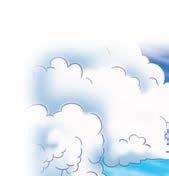







This summer vacation, Ragini is going to her village. She is very
happy.
She asks her father, “How will we go to the village?”
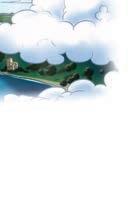
He says, “Our village is very far. First, we will go to the airport. From aeroplane
“Wow,” says Ragini, “we will fly high in the sky!”
“Yes, Ragini dear“ says father. “From the airport, we will take a


to Ranchi.” taxi, and go to the train station” says father.








the meaning of the words while reading the story. Associate the words with the


Sl. no.WordPronunciationMeaning
Sl. no. Word Pronunciation Meaning
aeroplane euh a vehicle that flies in the air and reaches places very quickly taxi tak a vehicle with four wheels that you rent to go to places, usually having a yellow number plate train a vehicle which runs on tracks, has smaller boxes attached together and has many seats in it
.ruh.playn

act to use your right hand and move it from down to up diagonally

.see
trayn
cycle rickshaw sai rik a vehicle which has three tyres and is pulled or pedalled by a man
act to put your right arm forward with a closed fist and rotate the arm in a circular way

act to put your left hand near the left edge of your mouth and move your right hand in circles near the right edge of your mouth
.kuhl .shaw
You may pause at the annotations and ask these suggested questions.


act to hold something horizontally with your hands at a distance, and move your legs up and down


How will Ragini go to Ranchi?
(Ragini will go by aeroplane.)
After
How will Ragini go to the train station? (Ragini will go by taxi to the train station.)
After
What will Ragini see from the train? (She will see farms and cows.)





After reaching the village, how will Ragini go to her grandfather’s house? (Ragini will go by cycle rickshaw.)

Refer to the next page for annotations 3 and 4.

In the story, we read how Ragini will use different modes of transport to reach her



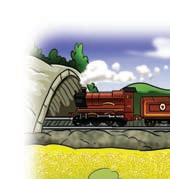



train chuk
chuk…”

grandfather’s house.”




too? Koooooooooo… chuk chuk chuk chuk

is going to be the best trip ever!”



“Hahaha! Yes! You will see farms and cows on the way. After reaching the village, we will take a cycle rickshaw to reach your “This









Explain

the meanings of these keywords in the learners’ home language.
1. Instruct: aeroplanes
from down to up diagonally. I watch many aeroplanes.
Repeat 5–6 times.
2. Instruct: Say
Say what I say. Do what I do. fly in the sky. Do the action of using your right hand and moving it
Say what I say. Do what I do.


A taxi has four wheels. Do the action of putting your right arm forward with a closed fist and rotating the arm in a circular way.
I sit in a taxi
Repeat 5–6 times.
3. Instruct: are very long.
Say what I say. Do what I do.
trains 5–6 times.
4. Instruct: has
Say what I say. Do what I do.
I sit in a cycle rickshaw.
Repeat 5–6 times.


Do the action of putting your left hand near the left edge of your mouth and moving your right hand in circles near the right edge of your mouth.
Do the action of holding something horizontally with your hands at a distance and moving your legs up and down.



Ask learners,
the learners, whom you may select randomly, to speak the sentences independently.
Instruct:
Repeat
Say: Now, you will tell me the sentences with these keywords. Tell me the sentence with the word ‘aeroplanes’. the process for all the keywords.



Conclusion
Say: Today,
oday, we learnt to speak words and sentences on modes of transport. We learnt to speak the words ‘aeroplanes’, ‘taxi’, ‘trains’ and ‘cycle rickshaw’; and use them in sentences. Homework
Say: Today, you will tell your parents about the words and the sentences that you learnt in the class. You will tell them about the words ‘aeroplanes’, ‘taxi’, ‘trains’ and ‘cycle rickshaw’ along with the actions and sounds made by these modes of transport.
•
Theme 3 Modes of Transport









How do I go
To the museum so far?
auto rickshaw

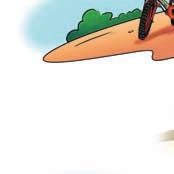







How do I go
To buy fruity cakes?

I ride a bicycle
To the shop that bakes.


Scooter, Or travel by car. van


How do I go
To the school every day?

In the school
Or rickshaw, if I may.

How do I go


To the pet shop?

Take the big bus And pay at the stop.







Say: Ragini’s Trip to the Village
Good morning, children! In the last class, we heard a story called . It was about a girl called Ragini. We heard how she reached her grandfather’s house using the different modes of transport. We also learnt the words ‘aeroplanes’, ‘taxi’,
‘trains’ and ‘cycle rickshaw’.

You may play a fun game with the learners. Tell them that you will make some sounds, and they have to recognise the modes of transport that produce the sounds.
Say: Let us have some fun! I will do some actions and you will say what they are.
Instruct:
Let us start.
Discuss the keywords learnt in the previous class.
Where do aeroplanes fly?
(The aeroplanes fly in the sky.)
2.
How many wheels are there in a taxi?
(A taxi has four wheels.)
3. What makes the sound ‘kooooo…chuk chuk’ and are very long? (Trains make the sound ‘kooooo…chuk chuk and are very long.)
4. How many wheels are there in a cycle rickshaw? (Cycle rickshaw has three wheels.)



Say:
That was amazing.
Instruct: Now, look at the pictures on page no. 20 carefully. Discuss some of these suggested questions while pointing at the pictures.
What do you see in the first picture?
(I see a bicycle. / I see a girl on a bicycle.)
Do you like to ride a bicycle?
2. (Yes, I like to ride a bicycle. / No, I do not like to ride a bicycle.)
What do you see in the third picture?
3. (I see a van. / I see a van with some children.)
Do you go to school by van?

4. (Yes, I go to school by van. / No, I do not go to school by van.)

You may compliment the learners on their responses and rephrase their responses into complete sentences and ask them to repeat those sentences. For example: A taxi has four wheels. Theme 3

Based on the learners’ responses, you may choose to ask a few follow-up questions on the illustrations.






Say: We will read a rhyme called Now, let us begin reading. You may choose to read play the Talking Book
How Do I Go? It is about how we go to different places.
the rhyme aloud or . The first read is for the purpose of enjoyment and the second read is for the explanation of the rhyme.
Say: language, if required.
Now, I will tell you what the rhyme means.
Do not forget to point at the pictures while reading or explaining the rhyme. Pause at regular intervals / after each sentence and explain the meaning in the learners’ home

10 mins

While reading the poem, you may point to the pictures in the book or show flash cards when you talk about a
Explain suggested actions and suggestions.

the meaning of the words while reading the rhyme. Associate the words with the

Sl. no. Word Pronunciation

bicycle bai.suh.kl a
.suh.kla vehicle with two tyres
scooter skoo.tuh


auto rickshaw aw.tow rik.shaw
car kaa
van van
bus buhs


act to sit on a chair and move your legs up and down alternatively to show the action of cycling
a vehicle with two tyres which runs on petrol act to hold an imaginary handle with your hands and move your wrists up and down a green or yellow vehicle which has three tyres and runs on petrol / CNG gas
show the flash card of an auto rickshaw

a vehicle that has four wheels and runs on petrol / diesel / CNG gas act to hold something vertically with your hands at a distance and move your hands up and down alternatively as if driving a vehicle that can only take a few people and usually takes children to school show flash cards of a van
a vehicle that can take many people and is bigger than the van show flash cards of a bus
You may pause at the annotations and ask these suggested questions.


How does ‘I’ go to the shop that bakes?


(‘I’ goes by bicycle.)

(‘I’ goes to school in the school van.)
Refer to the previous page for annotations.

How does ‘I’ go to the pet shop? (‘I’ goes to the pet shop by bus.)

In this rhyme, we read about how we go to different places using different modes of






Explain

the meanings of these keywords in the learners’ home language.
Say what I say. Do what I do.
1. Instruct: bicycle. down
I ride a bicycle.
Repeat 5–6 times.
2. Instruct: scooter
Do the action of sitting on the chair and moving your legs up and down alternatively to show the action of cycling.
Say what I say. Do what I do.



My father has a scooter
Repeat 5–6 times.
3. Instruct: Say what I say.
auto rickshaw
Do the action of holding an imaginary handle with your hands and moving your wrists up and down.
Show the flash card of an auto rickshaw. We sit in an auto rickshaw
Repeat 5–6 times.
4. Instruct: blue car
Say what I say. Do what I do.
A car has four wheels. 5–6 times.
Do the action of holding something vertically with your hands at a distance and moving your hands up and down alternatively as if driving.







Ask
Say:
the learners, whom you may select randomly, to speak the sentences independently. Now, you will tell me the sentences with these keywords.
Instruct: Tell me the sentence with the word ‘bicycle’. Repeat the process for all the keywords.




If time permits, you may also invite the learners to speak the sentences with the words learnt in period 1—‘aeroplanes’, ‘taxi’, ‘trains’ and ‘cycle rickshaw’.
Conclusion
Say: Say:
Today, we learnt to speak words and sentences on different modes of transport. We talked about how we go to different places. We learnt to speak the words ‘bicycle’, ‘scooter’, ‘auto rickshaw’ and ‘car’; and use them in sentences.
Homework
Today, you will tell your parents about the words and the sentences learnt in the class and show their actions or pictures from the book. You will tell them about the words ‘bicycle’, ‘scooter’, ‘auto rickshaw’ and ‘car’.
Theme 3



2 mins




I fly very high.

I am an aeroplane!
I roam in the sky.


I am found in rivers.
On water, I float.
My body is of wood.

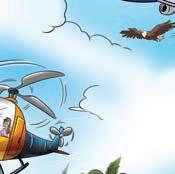
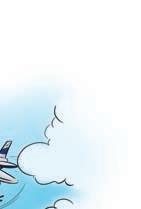
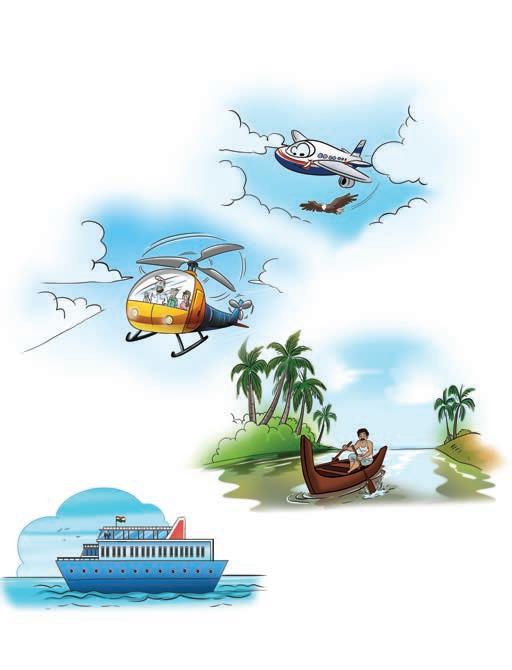




Blades go round and round, Up above the ground.
I am a helicopter! I take you around.


I am a little boat! ship!


Over seas and oceans, If you take a trip, You sail on me.
Hi, I am a






Hello, children! In the last class, we heard a rhyme called how we go to different places. We also learnt the new words ‘bicycle’, ‘scooter’, auto


Say: Let us have some fun! I will do some actions or show pictures and you will say what they are.
Instruct:
Say: How Do I Go? It was about rickshaw’ and ‘car’. Let us start.
Discuss the keywords learnt in the previous class.
What is the colour of your bicycle?
(I have a red bicycle.)
Do you ride on a scooter?
(Yes, I ride on the scooter.)
2. 3.
Do you sit in an auto rickshaw?
(Yes, I sit in an auto rickshaw.)
4.
What is the colour of your car?
(I have a blue car.)



You may rephrase the learners’ responses into complete sentences and ask them to repeat those sentences. For example: I have a red bicycle.
Say:
Great! That was fun.
Instruct: Now, look at the pictures on page no. 21 carefully.
Discuss some of these suggested questions while pointing at the pictures.
What do you see in the first picture?
(I see an aeroplane and a bird.)
2.
Where do aeroplanes fly?
(Aeroplanes fly in the sky.)
3.
What do you see in the third picture?
(I see a boat. / I see a man. / I see trees.)
4.
Where is the boat?
(The boat is in the water.)


Based on the learners’ responses, you may choose to ask a few follow-up questions on the illustrations.
Theme 3







Who Am I?
Say: We will read a rhyme called In this rhyme, some clues are given to guess us begin reading.
You may choose to read play the Talking Book. The first read is for the
the mode of transport. We will read the clues and guess the modes of transport. Now, let the rhyme aloud or purpose of enjoyment and the second read is for the explanation of the rhyme.

Before telling the answer, you may let the learners guess the mode of transport while reading the poem. You may also add some other hints.
Say:
Now, I will tell you what the rhyme means. required.
Do not forget to point at the pictures while reading or explaining the rhyme. Pause at regular intervals / after each sentence and explain the meaning in the learners’ home language, if required.

Explain the meaning of the words while reading the poem. Associate the words with the suggested actions and suggestions.

Sl. no. Word Pronunciation Meaning

aeroplane euh.ruh.playn
boat bote
trip trip
1

to go somewhere

a vehicle that flies in the air and reaches places very quickly act to use your right hand and move it from down to up diagonally a vehicle that floats in water and is usually made of wood act to put your hands to your sides as if holding sticks and move them
in a circular way
show a flash card or picture of people with packed bags at a railway station, airport or harbour a vehicle that floats on water, is bigger than a boat and is seen in seas and oceans show a flash card or picture of a You may pause at the annotations and ask these suggested questions.
What has wings and flies very high?
(An aeroplane has wings and flies very high.)
After 2
What has blades that go round and round and flies in the sky?
(A helicopter has blades and flies in the sky.)
Note: Refer to the previous page for annotations. Summarise
ship ship ship


After the


What is made of wood and floats in rivers?
(A boat is made of wood and floats in rivers.)
What floats in seas and oceans?
(A ship floats in seas and oceans.)

You may rephrase the learners’ responses into complete sentences and ask them to repeat those sentences with you. For example: An aeroplane has wings and flies very high.


Say: In this rhyme, we read about some modes of transport that fly in the sky and float in the water.




Explain

the meanings of these keywords in the learners’ home language.
Say what I say. Do what I do.
1. Instruct: is used on rivers. your Boat is small.
Repeat 5–6 times.
2. Instruct: Say what I say.
The ship is very big.


Do the action of putting your hands at your sides as if holding sticks and moving them in a circular way.
Show flash cards of a ship. I see a ship in the sea. 5–6 times.
3. Instruct: Say what I say. van
Show flash cards of a van. I sit in a van.
Repeat 5–6 times.
4. Instruct: Say what I say. bus
Show flash cards of a bus. I sit in a bus
Repeat 5–6 times.



If the learners struggle to repeat the sentences, you may ignore the articles and prepositions in the sentences. For example: I go school in van. You may avoid this strategy if you feel that the learners are getting proficient in their English speaking.

Ask
the learners, whom you may select randomly, to speak the sentences independently.
Instruct:
Repeat
Say: Now, you will tell me the sentences with these keywords. Tell me the sentence with the word ‘boat’. the process for all the keywords.

If time permits, you may also invite the learners to speak the sentences with the words that were learnt in periods 1 and 2—‘aeroplanes’, ‘taxi’, ‘trains’, ‘cycle rickshaw’, ‘bicycle’, ‘scooter’, ‘auto rickshaw’ and ‘car’.
Conclusion
Say:

E & R
Today, we learnt to speak words and sentences on modes of transport. We read about different modes of transport that can fly in the sky and float in the water. We learnt to speak the words and sentences on ‘van’, ‘bus’, ‘boat’ and ‘ship’; and use them in sentences.
Homework
Say: Today, you will tell your parents about the words and the sentences learnt in the class. You will tell them about the words ‘van’, ‘bus’, ‘boat’ and ‘ship’. You may also ask your parents whether they have ever sat in any of these modes of transport.
Theme 3




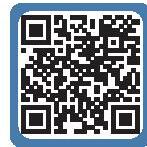





rickshaw I sit in an auto rickshaw.






















Cycle rickshaw has three wheels.











Discuss

the keywords learnt in periods 1, 2 and 3.
1. Instruct: are very long.
Say what I say. Do what I do.
I watch trains
Repeat 5–6 times.
2. Instruct:
Say what I say. Do what I do.


Do the action of putting your left hand near the left edge of your mouth and moving your right hand in circles near the right edge of your mouth.
I sit in a cycle rickshaw.
Repeat 5–6 times.
Say what I say. Do what I do.
I ride a bicycle
has three wheels. Do the action of holding something horizontally with your hands, and moving your
legs up and down.
3. Instruct: bicycle. action of cycling.
Repeat 5–6 times.
4. Instruct: Say what I say. bus
I sit in a bus
Repeat 5–6 times.
Repeat


the process for all the keywords.

Do the action of sitting on the chair and moving your legs up and down alternatively to show the
Point at the illustrations or flash cards showing a bus.

Say: words related to modes of transport.
Invite as
Instruct: Tell
Now, I will call you, one by one, so that you can speak the sentences for the words
Repeat E & R
as many learners as possible to say the sentences. Tell me the sentence with the word ‘van’. the process for all the keywords.

You may use the actions or show flash cards while speaking the words so that the learners are able to associate and recall the sentences learnt for the words.

You may appreciate the learners if they share sentences other than those discussed in the class.





Say:



Now, turn to page no. 24 of your book.
Explain:
There are pictures of a road, clouds and water. There are also pictures of a boat, a car and an aeroplane. You have to match the mode of transport with the place where it runs, floats or flies. Then, colour it. For example: Boat floats on water. Match the boat with
water. Then, colour it.
Instruct: fly. Then, colour it.


You have to match the modes of transport with the place where they run, float or You may ask these suggested questions.

Say: transport.




In this chapter, we learnt to speak words and sentences related to modes of transport. We also learnt to make the sounds made by some of these modes of







As a part of the theme, learners will:
• learn to talk about the different people around who help us.


• learn to say some keywords, phrases and sentences related to people around us.


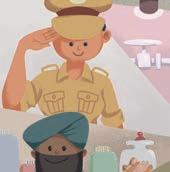





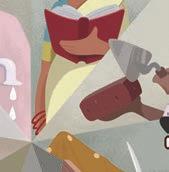







Say: listen


Hello, children! Today, you will listen to the story—Mehek’s Stomach Ache
You can use polite greetings like ‘Hey, sunshine! Ready for a great day?’, ‘Good morning!’, ‘How are you?’ or theme-based question like ‘Did you see the watchman at the school gate today?’ to begin the class.
Instruct: carefully.
Look at the picture on page no. 25 carefully. some of these suggested questions while pointing at the pictures.



Discuss while pointing at the pictures. 2. 3. 4.
What do you see in the picture?
(I see many people in the picture. / I see a doctor / a teacher / a tailor.)
Do you see a policeman in the picture?
(Yes, I see a policeman in the picture.)
Where do you see the police?
(I see the police on the road / near my school / near my house.)
Who do you think the lady with the book is?
(I think the lady with the book is a teacher.)



Point at the shopkeeper in the picture. Where do you meet a shopkeeper? (I meet a shopkeeper in a shop.)



Based on the learners’ responses, you may choose to ask a few follow-up questions on the


You may rephrase the learners’ responses into complete sentences and ask them to repeat those I see the police on the road

Say: Mehek’s Stomach Ache
You may choose to read play the Talking Book


Say: road.
Wonderful! Now, we will read a story called . It is about a girl named Mehek. She goes to the doctor because she has a stomach pain. She also meets a few more people. Now, let us begin reading. the story aloud or . The first read is for the purpose of enjoyment and the second read is for the explanation of the story.
Now, I will tell you what the story means.
Do not forget to point at the pictures while reading or explaining the story. Pause at regular intervals and explain the meaning in the learners’ home language, if required.



10 mins





Mehek has stomach pain. Her mother says, “Let us go to the doctor, “Nooooooo!!!! The doctor will give me an injection.’’ cries Mehek


Mehek.” loudly. kindly.

“No, Mehek! The doctor will help you feel better,’’ her mother says
teachers when we are sick.”
“How? Doctors don’t tell us stories and poems like ,’’ says


“Yes, dear! But they are kind and caring. They give us medicines











the meaning of the words while reading the story. Associate the words with the suggested actions and suggestions.


Sl. no. Word Pronunciation Meaning
doctor dawk
a person who treats us when we fall sick teachers tee
.tuh


Sl. no.WordPronunciationMeaning Action / Suggestion
act to wear a stethoscope around your neck and with one hand pretend to check your heartbeat by taking deep breaths
people who help us read and write in school medicines meh things that we eat to get well when we are sick hand


.chuhz
.duh.snz
point at yourself and ask the learners to point at you

act to take a small pill with your left hand and drink water from the right
sick sik well act driver drai a person who drives a car for money car shopkeeper shawp
.keep.uh


not feeling wellact to cough or sneeze
.vuh show flash card of a driver driving a
a person at a shop, from whom we buy things
you may do a small role-play of selling a few items and ask the learners who this person may be
You may pause at the annotations and ask these suggested questions.
What does Mehek think the doctor will give her? (Mehek thinks the doctor will give her an injection.)
After you and After
Does your teacher tell you stories and poems? (Yes, my teacher tells me stories and poems.)
Who drops Mehek and her mother at the doctor’s clinic? (The driver drops Mehek and her mother at the doctor’s clinic.)

What do Mehek and her mother buy from the shopkeeper? (Mehek and her mother buy fruits from the shopkeeper.)


Refer to the next page for annotations 3 and 4.





In this story, we read about Mehek and why she went to the doctor’s clinic. We also learnt about people around us who help us.






driver drops them at the doctor’s clinic.
The doctor checks Mehek’s stomach. “Does it pain here?”
asks the doctor.
“Ahhhhhh” says Mehek, in pain. He gives her a medicine.
Mehek feels good now.

fruit from the shopkeeper
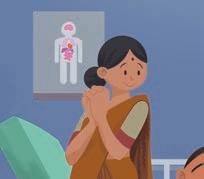

Mehek will eat fruits to stay healthy and fit.



Mehek and her mother are going back home. They buy some for Mehek.









Explain

the meanings of these keywords in the learners’ home language.
1. Instruct:
Say what I say. Do what I do.
doctor
The doctor
Repeat 5–6 times.
2. Instruct: Say teacher reads poems.
Say what I say. Do what I do.

gives us medicines. Do the action of wearing a stethoscope around your neck and with one hand pretending to check your heartbeat by taking deep breaths. gives me an injection.
I love my teacher
Repeat 5–6 times.

Do the action of pointing at yourself and asking the learners to point at you when saying the word ‘teacher’.
Say what I say. Do what I do.
3. Instruct: driver drives a car. Do the action of driving a car. The driver
Repeat 5–6 times.
4. Instruct: Say what I say. shopkeeper sells toys.
The shopkeeper
Repeat 5–6 times.


drives on the road. Show the flash card of a shopkeeper selling things. sells fruits.



Ask learners,
the learners, whom you may select randomly, to speak the sentences independently.
Instruct:
Repeat
Say: Now, you will tell me the sentences with these keywords. Tell me the sentence with the word ‘doctor’. the process for all the keywords.


You may show flash cards with things that a person uses and ask them who uses these things. For example: Show the pictures of medicines, injection, stethoscope, etc. and ask, ‘Who uses these?’
Conclusion
Say:
Today, we learnt to speak words and the sentences related to people around us. We talked about doctors, teachers, drivers and shopkeepers. We learnt to speak the words ‘doctor’, ‘teacher’, ‘driver’ and ‘shopkeeper’; and use them in sentences.
Homework
Say: Today, you will tell your parents about the words and the sentences that you learnt in the class. You will tell them about the words ‘doctor’, ‘teacher’, ‘driver’ and ‘shopkeeper’. You may ask your parents to take you to a shop to show you the shopkeeper there.
Theme 4





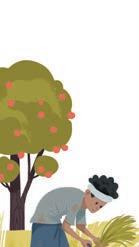


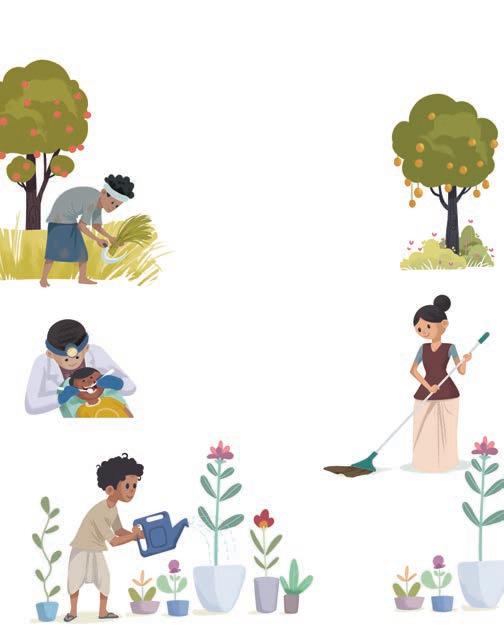

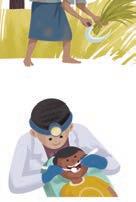
On them, everything depends.


The farmer grows the food.
cleans the school.
All the classrooms and the pool.

He makes our teeth clean and bright.
The sweeper dentist is dressed in white. gardener
grows plants and flowers.
He works hard for so many hours.
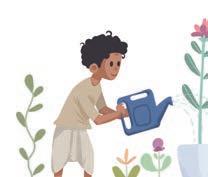
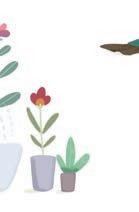





Say:



Good afternoon, children! In the last class, we heard a story called Mehek’s Stomach Ache It was about a girl called Mehek. We heard that she had a stomach ache and her mother took her to the doctor. We also learnt the words ‘doctor’, ‘teacher’, ‘driver’ and ‘shopkeeper’.
You can use one of the activities given in the front matter to grab the attention of the learners and to


Say:
Instruct: Let us start.
Discuss Fantastic! That was fun!




Let us have some fun! I will do some actions and you will say what I am doing. the keywords learnt in the previous class.




You may rephrase the learners’ responses into complete sentences and ask them to repeat those The doctor gives us medicines

2. (She is cleaning the floor.)
Do you see a sweeper in the picture? Point at the picture. (Yes, I see a sweeper in the picture.)
What do you think she is doing?

3. What is the man doing in the last picture?
(He is watering the plants.)
4. Who do you think he is? (I think he is a gardener.)

(He is a dentist / a doctor.) medicines.
Now, look at the pictures on page no. 28 carefully. some of these suggested questions while pointing at the pictures.
Who do you think the man in the third picture is?





Based on the learners’ responses, you may choose to ask a few follow-up questions on




Say: We will read a rhyme called


Our Helpers are Our Friends. It is about the people who help us in our daily life. Now, let us begin reading. the rhyme aloud or
You may choose to read play the Talking Book for
Say:
Now, I will tell you what the rhyme means.

. The first read is for the purpose of enjoyment and the second read is for the explanation of the rhyme.
Do not forget to point at the pictures while reading or explaining the rhyme. Pause at regular intervals / after each sentence and explain the meaning in the learners’ home language, if required.


10 mins
actions

Explain the meaning of the words while reading the rhyme. Associate the words with the suggested actions and suggestion.

Sl. no. Word Pronunciation Meaning

a person who works in the field and grows food
a person who keeps our surroundings clean
farmer faa.muh imaginary sickle
dentist den.tuhst teeth
gardener gaa.duhn.uh


act to hold an imaginary crop with your left hand and chop it using an
sweeper swee.puh across the floor
act to stand and hold an imaginary stick of a mop and pretend to rub it a person who treats our point at the flash card of a dentist
a person who takes care of the plants act to hold an imaginary watering can and pretend to water the plants
You may pause at the annotations and ask these suggested questions.
Note: Refer to the previous page for annotations.


Who makes our teeth clean and bright?

(The dentist makes our teeth clean and bright.)
Who grows plants and flowers?
(The gardener grows plants and flowers.)
If the learners respond correctly, you may rephrase their responses into complete sentences and ask them to repeat the sentences. For example: If a learner says ‘farmer’, you could rephrase it to ‘The farmer grows food’.
Summarise



Say: In this rhyme, we learnt about some people who help us in our daily lives. We learnt about the work that a farmer, a sweeper, a dentist and a gardener does.





the meanings of these keywords in the learners’ home language.
1. Instruct: Do what I do.
Say what I say. Do what I do.
farmer grows food
The farmer
Repeat 5–6 times.
2. Instruct:


Do the action of holding an imaginary crop with your left hand and chopping it using an imaginary sickle. grows food for us.
The sweeper
Repeat 5–6 times.
3. Instruct: Say what I say.
dentist
The dentist
Say what I say. Do what I do. sweeper cleans the school. Do the action of standing and holding an imaginary stick of a mop and pretending to rub it cleans the road. Show the flash card or an illustration of a dentist. cleans my teeth.
Repeat 5–6 times.
across the floor.
Say what I say. Do what I do.
4. Instruct: gardener plants.
The gardener
Repeat 5–6 times.

waters the plants. Do the action of holding an imaginary watering can and pretending to water the takes care of the plants.
Ask Say:


Instruct: Tell me the sentence with the word ‘farmer’. Repeat the process for all the keywords.
the learners, whom you may select randomly, to speak the sentences independently. Now, you will tell me the sentences with these keywords.

You may praise the learners for speaking confidently and correctly. You may say ‘Great!’, ‘Good work!’ or ‘Fantastic!’. If the learners hesitate, you may prompt them or guide them through actions or flash cards.



If time permits, you may also invite the learners to speak the sentences with the words learnt in period 1—‘doctor’, ‘teacher’, ‘driver’ and ‘shopkeeper’.
Homework
Say: Say: your
Today, we learnt to speak words and the sentences on people who help us daily. We talked about farmers, sweepers, dentists and gardeners. We learnt to speak the words ‘farmer’, ‘sweeper’, ‘dentist’ and ‘gardener’; and use them in sentences.
Today, you will tell your parents about the words and the sentences learnt in the class. You will tell them about the words ‘farmer’, ‘sweeper’, ‘dentist’ and ‘gardener’. You may ask your parents to take you around your locality and show these people to you.



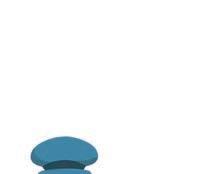







People around us, big and small, Work day and night to help us all.
watchman
The baker
keeps us safe, bakes us yummy cakes.
The painter
paints apples and pears, The carpenter makes tables and chairs,

The doctor
The tailor
asks us to eat fruits, stitches our pants and suits.
People around us, big and small
Work every day to help us all.
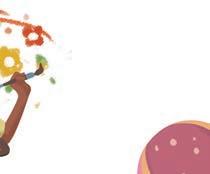












Say: .
Hello, children! In the last class, we heard a rhyme called Our Helpers are Our Friends It was about people around us who help us. We also learnt the new words ‘farmer’, ‘sweeper’, ‘dentist’ and ‘gardener’.
You may include some movement or stretching exercises or actions, between the class, to keep the
Instruct: Let us start.


Discuss
What does a farmer do?
(The farmer grows food.)

Say: Let us have some fun! I will do some actions and you will say what I am doing. the keywords learnt in the previous class.
2. Who cleans the school?
(The sweeper cleans the school.)
3. Do you go to the dentist?
(Yes, I go to the dentist.)
4.
What does the gardener do?
(The gardener waters the plants.)


You may rephrase the learners’ responses into complete sentences and ask them to repeat those The farmer grows food.
Awesome! That was fun!
Now, look at the pictures on page no. 29 carefully. some of these suggested questions while pointing at the pictures.
Do you see a painter in the picture?
(Yes, I see a painter.)
2. Do you like to paint?
(Yes, I like to paint. / No, I do not like to paint.)
3.
Do you see a watchman in the picture? Point at the picture. (Yes, I see a watchman in the picture.)



4. (I see a cake and muffins.)
What do you see in the second picture?

Based on the learners’ responses, you may choose to ask a few follow-up questions on






Say: We will read a rhyme called
People Around Us. It is about people who live around us and help us. Now let us begin reading.
You may choose to read play the Talking Book
the rhyme aloud or . The first read is for the purpose of enjoyment and the second read is for the explanation of the rhyme.
Say: required.

Now, I will tell you what the rhyme means. Do not forget to point at the pictures while reading or explaining the rhyme. Pause at regular intervals / after each sentence and explain the meaning in the learners’ home language, if required.

In advance, you may prepare a chef’s cap by folding a white sheet of paper in a cylindrical shape.
Explain suggested actions.

the meaning of the words while reading the poem. Associate the words with the

Sl. no. Word Pronunciation Meaning Action watchman vawch.muhn place baker bayk.uh cakes prepared painter paynt.uh a carpenter kaa.puhn.tuh hammer



a person who takes care of the safety of a act to blow a whistle by bringing your thumb and index finger of the right hand close to your mouth a person who makes act to wear the chef’s cap you have
doctor dawk.tuh tailor tay.luh our clothes
.uha person who paints act to hold an imaginary paint brush and make imaginary strokes of paint a person who makes tables and chairs act to hit on the table with an imaginary a person who treats us when we get sick act to wear a stethoscope around your neck and with one hand pretend to check your heartbeat by taking deep breaths a person who stitches act to hold an imaginary cloth in your left hand and pretend to stitch the cloth with an imaginary needle
You may pause at the annotations and ask these suggested questions.

(Yes, I like to eat cakes. / No, I do not like to
Note: Refer to the previous page for annotations. Summarise



After
What does a carpenter make? (A carpenter makes tables and chairs.)
After 4


Who stitches your clothes? (The tailor stitches my clothes.)
Say: In this rhyme, we read about people who live around us and help us.








Explain

the meanings of these keywords in the learners’ home language.
Say what I say. Do what I do.
1. Instruct: Do what I do. watchman
I see a watchman
Repeat 5–6 times.
2. Instruct:
keeps us safe. Do the action of blowing the whistle by bringing your thumb and index finger of the right hand close at the gate.
to your mouth.
Say what I say. Do what I do.


The baker bakes bread.
baker bakes cakes. prepared.
Repeat 5–6 times.
3. Instruct: painter
Say what I say. Do what I do.
Do the action of wearing the chef’s cap you have

paints flowers. Do the action of holding an imaginary paint brush
Repeat 5–6 times.
Say what I say. Do what I do.
4. Instruct: tailor imaginary needle.
and making imaginary strokes of paint. The painter paints fruits.
makes our dress. Do the action of holding an imaginary cloth in your left hand and pretending to stitch the cloth with an
The tailor makes my shirt.
Repeat 5–6 times.
Ask
Say:
Instruct:



the learners, whom you may select randomly, to speak the sentences independently. Now, you will tell me the sentences with these keywords. Tell me the sentence with the word ‘watchman’.
Repeat the process for all the keywords.



Homework

Today, we learnt to speak words and sentences on people around us who help us. We learnt to speak the words ‘watchman’, ‘baker’, ‘painter’ and ‘tailor’; and use them in sentences.
Say: your E & R
Theme 4

Say: Today, you will tell your parents about the words and the sentences learnt in the class. You will tell them about the words ‘watchman’, ‘baker’, ‘painter’ and ‘tailor’. You may also ask your parents to show you these people in real life.








































Discuss

the keywords learnt in periods 1, 2 and 3.
1. Instruct: Do what I do.
Say what I say. Do what I do.
doctor
The doctor
Repeat 5–6 times.
2. Instruct: sweeper floor.

The sweeper

gives us medicines. Do the action of wearing a stethoscope around your neck and with one hand pretending to check your heartbeat by taking deep breaths. gives me an injection.
Say what I say. Do what I do. cleans the school. Do the action of standing and holding an imaginary stick of a mop and pretending to rub it across the cleans the road.
Repeat 5–6 times.
3. Instruct: tailor imaginary needle.

Say what I say. Do what I do. makes our dress. Do the action of holding an imaginary cloth in your left hand and pretending to stitch the cloth with an
The tailor makes my shirt.
Repeat 5–6 times.
4. Instruct: baker bakes cakes.
Say what I say. Do what I do.
The baker bakes bread.
Repeat 5–6 times.
Repeat


Do the action of wearing the chef’s cap you have prepared. the process for all the keywords.
E & R Express
Invite as
Instruct: Tell

Say: words related to people who help us.

Now, I will call you, one by one, so that you can speak the sentences for the words as many learners as possible to say the sentences. Tell me the sentence with the word ‘watchman’. the process for all the keywords.
Repeat E & R
You may appreciate the learners if they share sentences other than those discussed in the class.














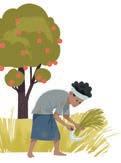






















Say:



Now, turn to page no. 32 of your book.
Explain:
Pictures of some people are given on the left-hand side. Pictures of the things that they use are given on the right-hand side.
Instruct:
Match the people with the things they use and then colour them. You may ask these suggested questions.
Who uses an injection?


(A doctor uses an injection.)
2.
Who uses scissors and needles?
(A tailor uses scissors and needles.)
3. A farmer uses a tractor.)
What does a farmer use in the field—scooter, bicycle or tractor?
Say: around us who help us.


In this chapter, we learnt to speak words, phrases and sentences related to people










As a part of the theme, learners will:
• learn to talk about things we play with and how we play.


• learn to say some keywords, phrases and sentences related to games.



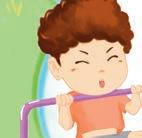
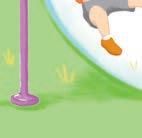










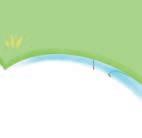








Good morning, precious gems! Today, you will listen to the story—
Say: Golu Learns to Cycle.

You can use polite greetings like ‘Good morning!’, ‘How are you?’ or ‘How are you feeling today?’ or ask theme-based question like ‘Which is your favourite game?’ to begin the class.
Instruct: Look at the picture on page no. 33 carefully. Discuss some of these suggested questions while pointing at the pictures.

What do you see in the picture?
(I see a boy playing games. / I see a boy swimming / playing football / skating.)
Do you like to play football?
2. (Yes, I like to play football. / No, I do not like to play football.)
Which games do you play in the park?
3. (I play run-and-catch / cricket / hide-and-seek / ice-and-water.)

Do you want to learn how to swim?
4. (Yes, I want to learn how to swim. / No, I do not want to learn how to swim.)




Based on the learners’ responses, you may choose to ask a few follow-up questions on the cover page.



Say:
Awesome! Now, we will read a story called . It is about a boy read the story aloud or play the . The first read is for the Now, I will tell you what the story means. I play run-and-catch.
Say: Golu Learns to Cycle named Golu. Golu’s sister helps him learn how to ride a bicycle. Now, let us begin reading. You may choose to Talking Book purpose of enjoyment and the second read is for the explanation of the story.
Do not forget to point at the pictures while reading or explaining the story. Pause at regular intervals and explain the meaning in the learners’ home language, if required.


You may read the story with voice modulation, hand gestures and expressions to make it more interesting for your learners.

10 mins





2


Golu wants to ride his new bicycle. It is a little red

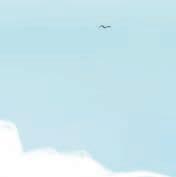

Golu wants to ride his bicycle but
bicycle with a basket. bat and a . are flying kites football. he is scared.


Golu wakes up early in the morning. He goes to the park with his elder sister Ginni. There are many other children in the park. Some are playing with a ball Others are having fun on the swings. A few kids . Some are playing



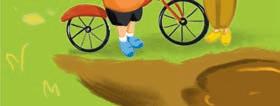








the meaning of the words while reading the story. Associate the words with the suggested actions and suggestion.


Sl. no.WordPronunciation
bicycle bai.suh.kl a bat bat cricket to hit a ball
.suh.kla vehicle with two wheels

ball bawl
kites kites
football fut.bawl


Sl. no. Word Pronunciation Meaning Action / Suggestion
act to sit on a chair and move your legs up and down alternately to show the action of cycling
a piece of wood used in act to turn and bend your body sideways, hold an imaginary bat in your hand and hit it diagonally act to hold an imaginary ball in your hand and throw it forward
a round thing used to play games like cricket, football, catch, etc.
things made of paper which are attached to a string and fly in the air
a game in which you play by kicking a ball
You may pause at the annotations and ask these suggested questions.



act to hold a string in your hand diagonally and move your hands up and down alternately show the flash card or an illustration of children playing football


What does Golu want to do?
(Golu wants to ride his new bicycle.)
After and playing football.)
What were the other children doing in the park?
After

What does Golu wear before riding the bicycle? (Golu wears a helmet before riding the bicycle.)




(The other children were playing bat and ball / having fun on the swings / flying kites (Ginni will hold the bicycle from the back.)

Refer to the next page for annotations 3 and 4.
In this story, we read about a boy named Golu. He wants to learn how to ride a bicycle. His sister, Ginni, teaches him how to ride a bicycle.
• Games Time





Golu tells his sister, “Please help me. I want to learn to ride
the bicycle.”
Ginni says, “Sure, Golu! I will hold the bicycle from the back.”





Golu wears his helmet and hops onto the bicycle. Ginni holds the bicycle for some time. Then, she leaves the cycle. Golu starts to ride on his own.
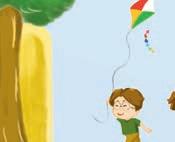



“Yoohoooooo, I did it!”, shouts Golu.
“Tring-tring! Tring-tring!”, Golu rings the bell!













Explain

the meanings of these keywords in the learners’ home language.
1. Instruct: bicycle is red.
Say what I say. Do what I do.
I ride a bicycle.
Repeat 5–6 times.
2. Instruct: .
Say what I say. Do what I do.
I bounce the ball
I throw the ball
Repeat 5–6 times.
3. Instruct: Say kite.
I fly a kite in the sky.
Repeat 5–6 times.
4. Instruct: Say what I say. football.
I play with a football.
Repeat 5–6 times.
Do the action of sitting on a chair and moving your legs up and down alternately to show the action of cycling.


Do the action of holding an imaginary ball in your hand and throwing it forward.
Say what I say. Do what I do.


Do the action of holding a string in your hand diagonally and moving your hands up and down alternately.
13 mins

Show the flash card or an illustration of children playing football.


E & R Express
E&R
Ask learners,
the learners, whom you may select randomly, to speak the sentences independently.
Instruct:
Repeat
Say: Now, you will tell me the sentences with these keywords. Tell me the sentence with the word ‘bicycle’. the process for all the keywords.



Conclusion
Say: games E
Today, we learnt to speak words and the sentences related to games. We talked about some games that we play. We learnt to speak the words ‘bicycle’, ‘ball’, ‘kite’ and ‘football’; and use them in sentences.
Homework
Say: Today, you will tell your parents about the words and the sentences that you learnt in the class. You will also show the actions for those words. You will tell them about the words ‘bicycle’, ‘ball’, ‘kite’ and ‘football’.
Theme 5
• Games Time



5 mins



Let us play, both in and out

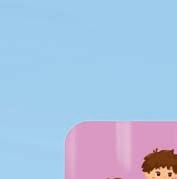
It’s ludo
We are happy, let us shout. time, roll a dice,
Playing with friends, is so nice.
Run and hide, in a secret place
Find your friend, with a happy face.
On your mark, get set go
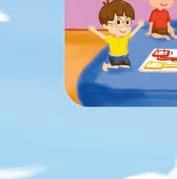




Hold the bat


Let us race, to and fro. , swing and hit
It is fun, to play cricket.
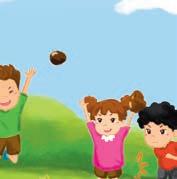
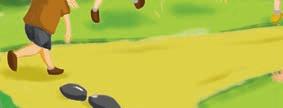










Say: . It was ‘kite’
Hello, children! In the last class, we heard a story called Golu Learns to Cycle about a boy called Golu. Golu’s sister Ginni helped him learn how to ride a bicycle. We also learnt the words ‘bicycle’, ‘ball’, ‘kite’ and ‘football’.
You can use one of the activities given in the front matter to grab the attention of the learners and to


Say:
Instruct: Let us start.
Discuss





Let us have some fun! I will do some actions and you will say what they are. the keywords learnt in the previous class.



You may rephrase the learners’ responses into complete sentences and ask them to repeat those
Great! That was fun.

3.
4. I fly a kite.
Now, look at the pictures on page no. 36 carefully. some of these suggested questions while pointing at the pictures.
What do you see in the first picture?
(I see four children playing a game / ludo.)
2. Do you like to play ludo?
(Yes, I like to play ludo. / No, I do not like to play ludo.)
What are the children playing in the second picture?

(The children are playing cricket.)
Do you like to play in the house or in the park?

(I like to play in the house. / I like to play in the park.)





Based on the learners’ responses, you may choose to ask a few follow-up questions on






Say: We will read a rhyme called You may choose to read play the Talking Book for
Say: language, if required.


Let Us Play. It is about the games that we play in the house and the games that we play in the park. Now, let us begin reading. the rhyme aloud or . The first read is for the purpose of enjoyment and the second read is for the explanation of the rhyme.
Now, I will tell you what the rhyme means. Do not forget to point at the pictures while reading or explaining the rhyme. Pause at regular intervals / after each sentence and explain the meaning in the learners’ home the meaning of the words while reading the rhyme. Associate the words with the
You may ask each learner which games they play in the house and with whom.
Explain suggested actions.
10 mins


Sl. no. Word Pronunciation Meaning Action

1 play play kick kik ludo loo.doh race race bat bat it diagonally
to enjoy some sports or game act to hold an imaginary racket in your hand and hit an imaginary shuttlecock with it to use your leg and hit something, usually a ball act to kick an imaginary ball with your foot a game played among 2–4 people with a dice act to roll a dice and throw it on an imaginary ludo board


racerace a game in which two or more people run to win act to run a few steps a piece of wood used to hit a ball act to turn and bend your body sideways, hold an imaginary bat in your hand and hit
You may pause at the annotations and ask these suggested questions.

In which game do we roll a dice?
(In ludo, we roll a dice.)



Refer to the previous page for annotations.

In which game do we find our friend?
(In run-and-hide, we find our friend. / In hide-and-seek, we find our friend.)


In which game do we hold a bat and swing it (In cricket, we hold a bat and swing it.)

You may also ask the learners some other games in which they roll a dice, like snakes and ladders. Also, ask them if they have ever played hide-and-seek and if they enjoyed playing it.

In this rhyme, we learnt about games that we play in the house and the games that


Explain




the meanings of these keywords in the learners’ home language.
1. Instruct: Do bat.
Say what I say. Do what I do.
bat I play with a bat.
Repeat 5–6 times.
2. Instruct:
I like to play ludo
Do the action of turning and bending your body sideways, holding an imaginary bat in your hand and hit it diagonally.
Say what I say. Do what I do.


imaginary ludo board. I play ludo
Do the action of rolling a dice and throw it on an with my brother.
Repeat 5–6 times.
3. Instruct: race.
Say what I say. Do what I do.
Do the action of running a few steps.
I run fast in the race.
Repeat 5–6 times.
4. Instruct:
Say what I say. Do what I do.
kick the football.
I kick the big ball.
Repeat 5–6 times.

Ask
Say:
Instruct: Tell
Repeat
13 mins


Do the action of kicking an imaginary ball with your foot.
You may show flash cards of different games that children play in the house and outside the house. Then, for each game you can ask how many learners play that game. E&R
the learners, whom you may select randomly, to speak the sentences independently. Now, you will tell me the sentences with these keywords. Tell me the sentence with the word ‘bat’. the process for all the keywords.

You may praise the learners for speaking confidently and correctly. You may say ‘Good work!’, ‘Keep it up!’ or ‘You said it nicely!’. If the learners hesitate, you may prompt them or guide them through actions.


If time permits, you may also invite the learners to speak the sentences with the words learnt in period 1—‘bicycle’, ‘ball’, ‘kite’ and ‘football’.
Say: Homework
Say: parents
Today, we learnt to speak words and the sentences related to games. We talked about games that we play in the house and games that we play in the park. We learnt to speak the words ‘bat’, ‘ludo’, ‘race’ and ‘kick’; and use them in sentences.

Today, you will tell your parents about the words and the sentences learnt in the class. You will tell them about the words ‘bat’, ‘ludo’, ‘race’ and ‘kick’. You can ask your parents to play a game with you related to any of the words learnt today.
• Games Time






Cheer and play, Laugh and share, Play every day.

Three, two, one Bounce the ball, All of us play, Big or small.



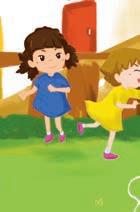
Hop and skip, And kick and run Jump up high, To reach the sun.
Let us play, You and I. Win or lose, Never cry!


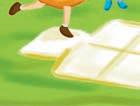
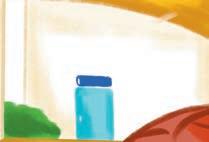




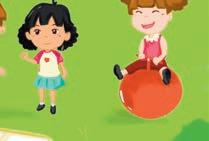








Good morning, children! In the last class, we heard a rhyme called about the games that we play in the house and games that we play in the park. We also learnt the new words ‘bat’, ‘ludo’, ‘race’ and ‘kick’.



Say: Let us have some fun! I will do some actions and you will say what they are.
Instruct:
Say: Let Us Play. It was Let us start.
Discuss the keywords learnt in the previous class.

You may rephrase the learners’ responses into complete sentences and ask them to repeat those sentences. For example: I like to play ludo.
Say:
Brilliant! That was interesting.


Instruct: Now, look at the pictures on page no. 37 carefully. Discuss some of these suggested questions while pointing at the pictures.

What do you see in the picture?
(I see children playing many games.)
2.
Where are the children playing?
(The children are playing in the park.)
(Two children are playing skip the rope.)
3. How many children are playing skip the rope?
4.
Do you like to play run and chase?

(Yes, I like to play run and chase.)



5.

Do the children look happy?
(Yes, the children look happy.)



Based on the learners’ responses, you may choose to ask a few follow-up questions on the illustrations.





Say: We will read a rhyme called You may choose to read play the Talking Book
Sports are Fun. The rhyme tells us that we should play games every day. Now, let us begin reading.
the rhyme aloud or . The first read is for the purpose of enjoyment and the second read is for the explanation of the rhyme.
You may read the rhyme with voice modulation, hand gestures and in rhythm to make it interesting for the learners.
Say: Now, I will tell you what the rhyme means.

Do not forget to point at the pictures while reading or explaining the rhyme. Pause at regular intervals / after each sentence and explain the meaning in the learners’ home language, if required.
10 mins
Explain the meaning of the words while reading the poem. Associate the words with the suggested actions.
Sl. no. Word Pronunciation



1 ball bawl kick kik foot jump juhmp then bring it down then bring it down run run to move very fast win win lose looz it side to side

Sl. no.WordPronunciation Meaning Action a round thing used to play games like cricket, football, catch act to hold an imaginary ball in your hand and throw it forward to use your leg and hit something, usually a ball act to kick an imaginary ball with your to push yourself up in the air for just a second using your leg and act to push your body up in the air and

act to close your fists and move your hands forward and backward alternately to come first in a game or a race act to smile and spread both your hands outwards and upwards to come last in a game or a race act to bend your head down and move
You may pause at the annotations and ask these suggested questions.
1
What should we do every day?
(We should play every day. / We should laugh, share and play every day.)
After 2
What do we bounce?
(We bounce the ball.)

After
(We should jump high to reach the sun.)
Do you cry when you lose a game?
I cry when I lose a game.)

(No, I do not cry when I lose a game. / Yes,

For annotations 1 to 3, you may ask some learners whether they play every day or not, whether they bounce a ball and whether they jump high.
Summarise

You may guide the learners that they should not make fun of anyone if they ever lose a game.


Say: In this rhyme, we read that we should play every day and should never cry when we lose a game.



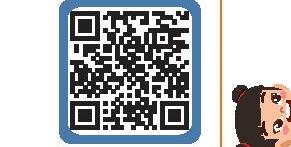









I run in the race. I kick the football. I run very fast. I jump very high. I play to win. I lose some games.



•




















Discuss

the keywords learnt in periods 1, 2 and 3.
1. Instruct:
Say what I say. Do what I do.
bicycle is red.
I ride a bicycle.
Repeat 5–6 times.
2. Instruct:
Say what I say. Do what I do.
I like to play ludo
I play ludo
Repeat 5–6 times.
3. Instruct:

Do action of sitting on a chair and moving your legs up and down alternately to show the action of cycling.

imaginary ludo board.
Say what I say. Do what I do.
run very fast.
Do the action of rolling a dice and throwing it on an with my brother.
I run in the race.
Repeat 5–6 times.
4. Instruct: lose some games. I lose sometimes.
Repeat 5–6 times.

Do the action of closing your fists and move your hands forward and backward alternately.
Say what I say. Do what I do.
Do the action of bending your head down and moving it from side to side.
Repeat the process for all the keywords.


Say: words related to things we play.
Invite as

10 mins


13 mins
Now, I will call you, one by one, so that you can speak the sentences for the words as many learners as possible to say the sentences. You may use the actions or show flash cards while speaking the words so that the learners are able to associate and recall the sentences learnt for the words.
Instruct: Tell me the sentence with the word ‘jump’. Repeat the process for all the keywords. E & R














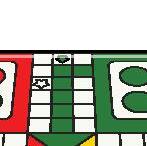
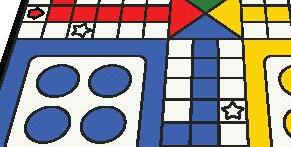





























Say:



Now, turn to page no. 40 of your book.
Explain: those
Pictures of some games that we play are given on the left-hand side. Pictures of the things with which we play those games are given on the right-hand side. You have to match the games with the things that are used to play those games. For example: We play with a bat and ball. So, match bat and ball.
Instruct:
game you like the most.


You have to match the things that are used to play that game. Then, circle the You may ask these suggested questions.

Do you play with a bat and ball?
(Yes, I play with a bat and ball.)
2. Who plays ludo with you? mother
(My mother plays ludo with me.)
3. know
Do you know how to play chess?
(No, I do not know how to play chess.)
Which game do you like the most?
4. most?

(I like ludo the most. / I like bat and ball the most.)





Say: In this chapter, we learnt to speak words, phrases and sentences related to the things that we play with and how we play them.







As a part of the theme, learners will:


• learn to talk about the different things they see when they look at the sky.
• learn to say some keywords, phrases and sentences related to the sky.


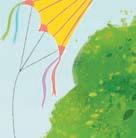
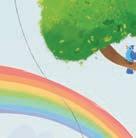
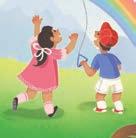
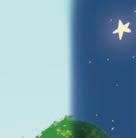








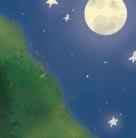







Good morning, little explorers. Today, you will listen to the story—


Say: Chutki Ate the Sun pointing
Instruct: Look at the picture on page no. 41 carefully. Discuss some of these suggested questions while pointing at the pictures.
What do you see on the left-hand side of the page?
(I see two children flying a kite. / I see a rainbow. / I see the sun.)
2. What do you see on the right-hand side of the page?
(I see the moon and the stars. / I see two children talking. / I see an owl.)
(I see the stars at night.)
3. Do you see the stars in the morning or at night?
4. Do you see the sun in the morning or at night?
(I see the sun in the morning.)


Based on the learners’ responses, you may choose to ask a few follow-up questions on the cover page.

I see the stars at night.

Chutki Ate the Sun. It is about a baby
Say: Wonderful! Now, we will read a story called elephant named Chutki. She eats the sun so that her mother does not feel hot. Now, let us begin reading.
You may choose to play purpose of enjoyment and the second read is for the explanation of the story.
Say:
read the story aloud or the Talking Book. The first read is for the Now, I will tell you what the story means.
Do not forget to point at the pictures while reading or explaining the story. Pause at regular intervals and explain the meaning in the learners’ home language, if required.






10 mins













Chutki is a baby elephant. Every day, she goes with her mother to the park. Today, it is too hot! Mother Elephant is thirsty. Chutki


Chutki puts lots of tables on top of each other. She climbs and reaches high in the sun round and orange! She opens her mouth and eats it. Everything is dark. There is no light. It looks like the night
sky. There is the —big, .








the meaning of the words while reading the story. Associate the words with the


Sl. no.WordPronunciation
Sl. no. Word Pronunciation Meaning Action
sky skai

the place above us where we see clouds, aeroplanes and birds flying
act to point towards the sky
sunsun
sun sun

a round ball of fire that dark dark
gives us light; we see it in
when we cannot see anything
light lite
when we can see everything night nite the time when we sleep


act to raise your arms above your head and join the fingers of both the hands to create a circle, forming the shape of the sun act to cover your eyes with your hands
act to cover your eyes with your hands and then remove your hands and open your eyes act to join your hands, tilt your head to the left and put your hands under your ears

You may tell these words in the learners’ home language for better understanding.

You may pause at the annotations and ask these suggested questions.

Where does Chukti go with her mother?
(Chutki goes to the park with her mother.)
After
How does the sun look?
(The sun looks big, round and orange.)
After



(Yes, the sun is back in the sky.)
Refer to the next page for annotations 3 and 4.



In the story, we read about Chutki, the baby elephant. She eats the sun because her mother feels hot. At the end of the story, she burps out the sun and sends it back to the sky.










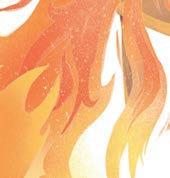



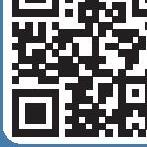

Chutki’s stomach is so big now! She runs to her mother and tells her
“My dear Chutki! The sun gives us light. It keeps us warm. Let us send the sun back to the sky,” says Mother to Chutki.
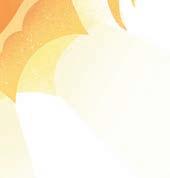

Chutki climbs the tables again and reaches the sky. She burps out the sun. “Buh-uuuurrrp!” Hurray! The sun is back in the sky.
•








Explain

the meanings of these keywords in the learners’ home language.
1. Instruct:
Say what I say. Do what I do.
sky is blue.
The sky is up.
Repeat 5–6 times.
2. Instruct: Say

Say what I say. Do what I do.
sun is hot.
sun is round. 5–6 times.
3. Instruct:

Do the action of pointing towards the sky.

Do the action of raising your arms above your head and joining the fingers of both the hands to create a circle, forming the shape of the sun.
Say what I say. Do what I do.
dark.
I cannot see in the dark
Repeat 5–6 times.
4. Instruct: night.
I see stars at night.
Repeat 5–6 times.

Do the action of covering your eyes with your hands.
Say what I say. Do what I do.
Do the action of joining your hands, tilting your head to the left and putting your hands under your ears.



Ask learners,
the learners, whom you may select randomly, to speak the sentences independently. Now, you will tell me the sentences with these keywords.
Instruct: Tell me the sentence with the word ‘sky’.
Repeat
Say: the process for all the keywords.
Say:

Today, we learnt to speak words and the sentences about the things we see in the sky. We learnt to speak the words ‘sky’, ‘sun’, ‘dark’ and ‘night’; and use them in sentences.
Homework

E & R

Say: Today, you will tell your parents about the words and the sentences that you learnt in the class and show their actions or point towards them. You will tell them about the words ‘sky’, ‘sun’, ‘dark’ and ‘night’.
Theme 6
• The Beautiful Sky





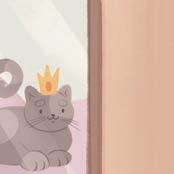
moon and round!

, pretty moon, So bright


You shine on my house.

You shine all around.
Pretty moon, pretty moon, Sometimes you are small. Some nights you are big,
Like a silver ball!


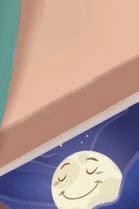




Pretty moon, pretty moon, glow
You always smile and . Sometimes you go hide, Sometimes say, “Hello!”



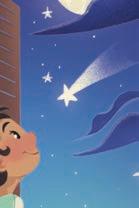





Say: heard Chutki Ate the Sun. It was about a eats
Hello, children! In the last class, we heard a story called baby elephant named Chutki. She climbs on tables and eats the sun because her mother feels hot. We also learnt the words ‘sky’, ‘sun’, ‘dark’ and ‘night’.


Say: Let us have some fun! I will do some actions and you will say what they are.
Instruct:
Let us start.
Discuss the keywords learnt in the previous class.





Say:
Wonderful! That was fun.
Instruct: Now, look at the pictures on page no. 44 carefully.

What do you see in the picture?
(I see a girl in a room.)

Discuss some of these suggested questions while pointing at the pictures.
2. What is the girl looking at outside the window?
(She is looking at the moon and the stars.)
3. Is it daytime or nighttime?


(It is nighttime.) moon.)
4. Do you also watch the stars and the moon?
You may rephrase the learners’ responses into complete sentences and ask them to repeat those sentences after you. For example: Theme

The sky is blue. • The Beautiful Sky



(Yes, I also watch the stars and the moon. / No, I do not watch the stars and the

Based on the learners’ responses, you may choose to ask a few follow-up questions on the illustrations.







Say: We will read a rhyme called who You may choose to read play the Talking Book for
Pretty Moon, Pretty Moon. It is about a girl who is looking at the pretty moon in the night sky. Now, let us begin reading.
the rhyme aloud or . The first read is for the purpose of enjoyment and the second read is for the explanation of the rhyme.
Now, I will tell you what the rhyme means.

Do not forget to point at the pictures while reading or explaining the rhyme. Pause at regular intervals / after each sentence and explain the meaning in the learners’ home language, if required.
Say: actions.

You may prepare a cut-out of the moon and the star prior to the class and show it to the learners while speaking about the words from the rhyme.
10 mins
Explain the meaning of the words while reading the rhyme. Associate the words with the suggested actions.


Sl. no. Word Pronunciation Meaning

moon moon
bright brite
shine shine
glow gloh
Note:
a round ball that we see in the sky at night point at the cut-out of the moon
something that gives light act to put one hand above the eyes and pretend to squeeze your eyes a little as if seeing a bright object
something that sends out light act to bring your hands near the side of your face, spread the fingers and shake
your hands
a light that is not very bright act to form a fist and then open your hand and spread your fingers

You may pause at the annotations and ask these suggested questions.
Refer to the previous page for annotations.


What does the moon always do?
(The moon always smiles and glows.)
(The moon says “Hello!”.)


Summarise



Say: In this rhyme, we read about the pretty moon and how it looks. Sometimes it looks big and sometimes small. It always smiles and glows.




Explain

the meanings of these keywords in the learners’ home language.
1. Instruct: Do what I do.
Say what I say. Do what I do.
moon is beautiful.
The moon shines.
Repeat 5–6 times.
2. Instruct:
The day is bright


Do the action of pointing at the cut-out of the moon.
Say what I say. Do what I do.
Do the action of putting one hand above the eyes and pretending to squeeze your eyes a little as if
The sun is bright
Repeat 5–6 times.
3. Instruct:
seeing a bright object.
Say what I say. Do what I do.
shines
The sun shines in the sky.
Repeat 5–6 times.
4. Instruct:
Say what I say. Do what I do.
The moon glows at night.
Repeat 5–6 times.

Do the action of bringing your hands near the side of your face, spreading the fingers and shaking your hands.
in the sky. Do the action of forming a fist and then opening your hands and spreading your fingers.
Ask


the learners, whom you may select randomly, to speak the sentences independently.
Say: Now, you will tell me the sentences with these keywords. Instruct: Tell me the sentence with the word ‘moon’. Repeat the process for all the keywords.



If time permits, you may also invite the learners to speak the sentences with the words learnt in period 1—‘sky’, ‘sun’, ‘dark’ and ‘night’.
Say: moon.
Homework
Say:
Today, you will tell your parents about the words and the sentences learnt in the class and show their actions. You will tell them about the words ‘moon’, ‘bright’, ‘shines’ and ‘glows’.

Theme 6
• The Beautiful Sky

Today, we learnt to speak words and the sentences on the moon. We talked about what the moon looks like. We learnt to speak the words ‘moon’, ‘bright’, ‘shines’ and ‘glows’; and use them in sentences.




, twinkle, tiny little star. .


So many of you, I make a wish, When you fall. You glow and shine Every night. I come to meet you, Flying on a kite.



• The Beautiful Sky


Dear Star









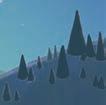




Say: Pretty Moon, Pretty Moon.
Hello, children! In the last class, we heard a rhyme called It was about how the moon looks. It shines and glows in the night sky. We also learnt the new words ‘moon’, ‘bright’, ‘shines’ and ‘glows’.


Say: Let us have some fun! I will do some actions or show the cut-out and you will say what they are.
Instruct:
Let us start.
Discuss the keywords learnt in the previous class.
How does the moon look?
(The moon looks beautiful.)
2.
Is the day bright?
(Yes, the day is bright.)
3.
Does the sun shine?
(Yes, the sun shines.)
4. (The moon glows in the sky.)
Where does the moon glow?




Say:
Great! That was amazing.
Instruct: Now, look at the pictures on page no. 45 carefully.
Discuss some of these suggested questions while pointing at the pictures.

What do you see in the picture?
(I see a girl and a kite. / I see the moon and the stars.)
2.
Where do you think the girl is going? going towards
3.
(I think the girl is going towards the moon.)
What is the colour of the moon?
(The colour of the moon is white.)
4. (The kite is green and purple.)
Can you tell the colour of the kite?




Do you see kites flying in the sky? the
(Yes, I see kites flying in the sky. / No, I do not see kites flying in the sky.)
Theme 6
The day is bright. You may compliment the learners if they speak in complete • The Beautiful Sky



Based on the learners’ responses, you may choose to ask a few follow-up questions on the illustrations.





Say: We will read a rhyme called Dear Star night. Now let us begin reading. You may choose to read play the Talking Book. The first read is for
. It is about how the stars look and shine every the rhyme aloud or the purpose of enjoyment and the second read is for the explanation of the rhyme.

You may read the rhyme with voice modulation, hand gestures and in rhythm to make it interesting for the learners.
Say:
Now, I will tell you what the rhyme means. required.
Do not forget to point at the pictures while reading or explaining the rhyme. Pause at regular intervals / after each sentence and explain the meaning in the learners’ home language, if required.

Explain the meaning of the words while reading the poem. Associate the words with the suggested actions.

Sl. no. Word Pronunciation Meaning

twinkle twing.kl constantly
tiny tai.nee
star staa

Action something that shines and changes from bright to dull act to spread your fingers and open and close your hands

far faa After
Where do the stars live?
(The stars live very far away. / The stars live in the sky.)
After 2

What does ‘I’ do when a star falls?
(‘I’ makes a wish when a star falls.)
Note: Refer to the previous page for annotations.
Summarise


something that is very small act to use your thumb and index finger and bring them closer with a little space in between small dots of light that fill the night sky point at the cut-out of the star something that is at a very long distance away from us act to move both your hands towards the right-hand side as if pushing something away from you You may pause at the annotations and ask these suggested questions. 1




What does the star do every night?
(The star glows and shines every night.)
How will ‘I’ go to meet the stars? (‘I’ will go flying on a kite to meet the stars.)

You may rephrase the learners’ responses into complete sentences and ask them to repeat those sentences after you. For example: The stars live very far away.


Say: In this rhyme, we read about how stars look in the sky at night. The girl wants to meet the stars. She will go flying on a kite to meet them.




Explain

the meanings of these keywords in the learners’ home language.
1. Instruct: Do what I do.
Say what I say. Do what I do.
twinkle
The stars twinkle
Repeat 5–6 times.
2. Instruct:
opening and closing your hands.
Do the action of spreading your fingers and in the sky.
Say what I say. Do what I do.

The stars look tiny

The ants are .
Repeat 5–6 times.
3. Instruct: stars at night. There are many stars
Repeat 5–6 times.
Do the action of using your thumb and index finger and brining them closer with a little space in between.
Say what I say. Do what I do.

Do the action of pointing at the cut-out of the star.
Say what I say. Do what I do.
4. Instruct: far away. towards The moon is far away.
Repeat 5–6 times.

Do the action of moving both your hands towards the right-hand side as if pushing something away from you.



Ask
the learners, whom you may select randomly, to speak the sentences independently. Now, you will tell me the sentences with these keywords.
Say: the process for all the keywords.
Instruct: Tell me the sentence with the word ‘twinkle’.
Repeat
If time permits, you may also invite the learners to speak the sentences with the words that were learnt in periods 1 and 2—‘sky’, ‘sun’, ‘dark’, ‘night’, ‘moon’, ‘bright’, ‘shines’ and ‘glows’.
Say:

Today, we learnt to speak words and sentences on stars. We read how they look in the night sky. We learnt to speak the words ‘twinkle’, ‘tiny’, ‘stars’ and ‘far’; and use them in sentences.
Homework

E & R
Say: Today, you will tell your parents about the words and the sentences learnt in the class and show their actions. You will tell them about the words ‘twinkle’, ‘tiny’, ‘stars’ and ‘far’.
Theme 6



































the keywords learnt in periods 1, 2 and 3.
1. Instruct: Do what I do. sky is blue.
Say what I say. Do what I do.
Do the action of pointing towards the sky.
The sky is high up.
Repeat 5–6 times.
Say what I say. Do what I do.
2. Instruct: moon.
The moon is beautiful.


The moon shines.
Repeat 5–6 times.
3. Instruct: stars at night.
Say what I say. Do what I do.
There are many stars.
Repeat 5–6 times.
Repeat
Do the action of pointing at the cut-out of the

Do the action of pointing at the cut-out of the star. the process for all the keywords.

Now, I will call you, one by one, so that you can speak the sentences for the words
Invite as many learners as possible to say the sentences.

Say: words related to the beautiful sky. as
Instruct: Tell me the sentence with the word ‘stars’. Repeat the process for all the words. E & R


You may use the actions or show the cut-outs while speaking the words so that the learners are able to associate and recall the sentences or phrases learnt for the words.
You may congratulate the learners if they share sentences other than those discussed in the class.










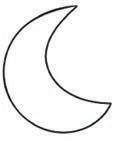


























Say:



Now, turn to page no. 48 of your book.
Explain:
There are some pictures without colours. Look at the pictures and say which of these you see in the sky. Then, colour them. For example: Look at the picture of the star. We see it in the sky so, we will colour it.
Instruct:
Look at the pictures and colour them if you see them in the sky. You may ask these suggested questions.


Do you see the stars in the sky?
(Yes, I see the stars in the sky.)
2. Where do you see the sun?
(I see the sun in the sky.)
3. Do you see trees in the sky?
(No, I do not see trees in the sky.)
4. Will you colour the moon?
Say:
(Yes, I will colour the moon. I see the moon in the sky.)
Yes, the


In this chapter, we learnt to speak words, phrases and sentences related to the beautiful sky. We read about the sun, the moon and the stars.








As a part of the theme, learners will:
• learn to talk about the things we see in nature.


• learn to say some keywords, phrases and sentences related to the nature.


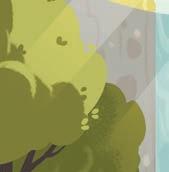
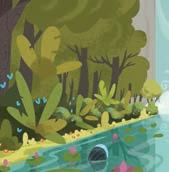
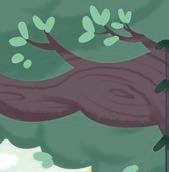













Good morning, little stars. Today, you will listen to the story—


Say: Rani Cleans the Park pointing

What do you see in the picture?
(I see trees / water / flowers.)
Instruct: Look at the picture on page no. 49 carefully. Discuss some of these suggested questions while pointing at the pictures.
2.
What is the colour of the flowers?
(The colour of the flowers is pink.)
3. (Yes, there are trees and flowers in my school.)


4. Have you ever seen a lot of water falling from a great height?
(Yes, I have seen a lot of water falling from a great height. / No, I haven’t seen a lot of
Are there trees and flowers in your school? water falling from a great height.)



Based on the learners’ responses, you may choose to ask a few follow-up questions on the cover page.
You may give a chance to as many learners as possible to respond to your questions. Also, you may encourage the learners to go out for a nature walk with their families to breathe fresh air.
You may rephrase the learners’ responses into complete sentences and ask them to repeat those sentences after you. For example: The colour of the flowers is pink.

Brilliant! Now, we will read a story called . It is about a girl named
You may choose to play purpose of enjoyment and the second read is for the explanation of the story.
Say:
read the story aloud or the Talking Book. The first read is for the Now, I will tell you what the story means.

Do not forget to point at the pictures while reading or explaining the story. Pause at regular intervals and explain the meaning in the learners’ home language, if required.

Say: Rani Cleans the Park Rani. She finds the park very dirty. She, along with other people, cleans the park. Now, let us begin reading.



10 mins





Rani goes to the park with her mother and aunt. has a lot of garbage. There are lots of plastic bags, old bottles and empty packets. The dustbins are broken.


2 park

“Eww, aunty! Why is this park so dirty?” asks Rani. She covers her nose with a hanky.
“No one cleans the park here.” says Rani’s mother.
“Can we clean this on our own?”
Rani asks.
“Yes! Let’s do it on Sunday. I will ask my friends for help.” says Rani’s aunt.
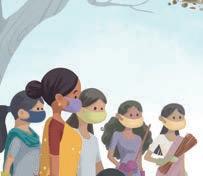



On Sunday, Rani and the others wear their gloves and masks. They bring
new dustbins too.
They pick up all the garbage and throw it in the dustbin. They also water the plants and trees.









the meaning of the words while reading the story. Associate the words with the suggested actions and suggestions.
You may bring a picture poster with the illustrations of grass, plant, trees and flowers to the class.

Sl. no.WordPronunciation
Sl. no. Word Pronunciation Meaning park paak




parkpaak and trees grow and we walk,
a place where many plants play or run plants plaants
a small living thing from which we get fruits, vegetables and flowers
trees treez
a tall plant that gives us shade, fruits, vegetables and nuts grass graas short green things that grow on the ground; we can walk on them
flowers flau.uhz


a part of the plant which is colourful and soft
You may pause at the annotations and ask these suggested questions.

What does the park have?
(The park has a lot of garbage.)
After
From whom will Rani’s aunt ask for help?
(Rani’s aunt will ask for help from her friends.)
After
Where do Rani and the others throw the garbage?

act to put your arms one over the other vertically and move them up and down diagonally like a seesaw

point at the illustration of a plant in the poster
point at the illustration of a tree in the poster
point at the illustration of grass in the poster
act to join your hands and open them with your fingers spread and let the lower part of the palms touch each other

(Rani and the others throw the garbage in the dustbin.)

How did the park look in the end?


(The park looked beautiful and clean.)
Refer to the next page for annotation 4.




In the story, we read about how Rani and the others cleaned the dirty park by throwing the garbage in the dustbin, and then watered the plants and trees.







grass trees and flowers






In one week, the park looks different! Children go there to play every day. It has soft green . It also has lots of . The bees and butterflies dance around. The park is beautiful and clean.










Explain

the meanings of these keywords in the learners’ home language.
1. Instruct: park
Say what I say. Do what I do.
The park is clean.
Repeat 5–6 times.
2. Instruct: Say what I say. plants
Plants are small.
Repeat 5–6 times.
3. Instruct: Say what I say. grass is soft.
The grass is green.
Repeat 5–6 times.
4. Instruct:
Do the action of putting your arms one over the other vertically and moving them up and down diagonally like a seesaw.


Point at the illustration of a plant in the poster.

Point at the illustration of grass in the poster.
Say what I say. Do what I do.
flowers are colourful. the palms touch each other.
The flowers are pink. 5–6 times.

Do the action of joining your hands and opening them with your fingers spread and letting the lower part of


Ask learners,
Say:
Instruct:
Repeat the process for all the keywords.


the learners, whom you may select randomly, to speak the sentences independently. Now, you will tell me the sentences with these keywords. Tell me the sentence with the word ‘park’.


You may encourage the learners to point at the illustrations or do the actions while speaking the sentences. For example: Point at the illustration of a plant in the poster and say ‘I like to grow plants’.
Today, we learnt to speak words and the sentences on things we see in a park. We learnt that we should always keep a park clean. We learnt to speak the words ‘park’, ‘plants’, ‘grass’ and ‘flowers’; and use them in sentences.
Homework
Say: your E & R
Say: Today, you will tell your parents about the words and the sentences that you learnt in the class and point at the pictures in the book. You will tell them about the words ‘park’, ‘plants’, ‘grass’ and ‘flowers’. You may also ask your parents to take you to a nearby park and show you all the things that you have learnt in the class.
Theme 7







river,

I see the mountains, So high, high, high. Green, brown or white, They touch the sky.
I see the
lakes,






I flow, flow, flow.
Let me tell you stories Of the places I go.
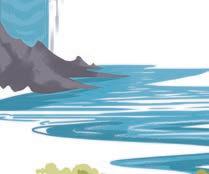
So blue, blue, blue.
They shine like a mirror, You can see you!

I see the forest,
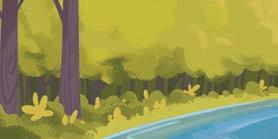
With trees tall, tall. Big wild animals, And streams that fall.
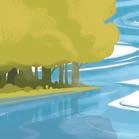






Hello, children! In the last class, we heard a story called about a girl named Rani. She found the park very dirty with garbage thrown everywhere. She, along with other people, cleaned the park. We also learnt the words ‘park’, ‘plants’,
Say: Rani Cleans the Park. It was ‘grass’ and ‘flowers’.


Say: Let us have some fun! I will do some actions or show pictures and you will tell what they are.
Instruct:
Let us start.
Discuss the keywords learnt in the previous class.





Say:
Wonderful! That was fun.
What do you see in the picture?
You may rephrase the learners’ responses into complete sentences and ask them to repeat those sentences. For example:
2.

What is the colour of the water? (The water is blue.)

Instruct: Now, look at the pictures on page no. 52 carefully. Discuss some of these suggested questions while pointing at the pictures.
(I see water / trees /mountains.)
Have you ever seen a mountain?
4.
What is the colour of the trees? (The trees are green.) I play in the park.

3. (Yes, I have seen a mountain. / No, I have not seen a mountain.)


Based on the learners’ responses, you may choose to ask a few follow-up questions on the illustrations.





Say: We will read a rhyme called
You may choose to read play the Talking Book for
Say:
The Places Where I Go. It is about a river that tells us that it flows and sees mountains, lakes and forests. Now, let us begin reading. the rhyme aloud or . The first read is for the purpose of enjoyment and the second read is for the explanation of the rhyme.
Now, I will tell you what the rhyme means. Do not forget to point at the pictures while reading or explaining the rhyme. Pause at regular intervals / after each sentence and explain the meaning in the learners’ home language, if required.


You may read the rhyme with voice modulation, hand gestures and in rhythm to make it interesting for the
Explain suggested actions or suggestion.
10 mins

the meaning of the words while reading the rhyme. Associate the words with the

Sl. no. Word Pronunciation

river ri.vuh
a large amount of water that flows in a long line
mountains mown.tnz
hills that are very high and lakes layks


an area of water which is surrounded by land
forest faw.ruhst a place where there are many trees and wild animals

Action / Suggestion act to bring your hands forward facing each other and your palms facing downward then wave your hands from the centre to the sides
have many rocks act to bring your hands forward and join the fingertips of both your hands and opening the palms from below act to join your hands up high, palms facing down and move them slightly up and down making a wave show the flash card of forests with trees and animals
You may pause at the annotations and ask these suggested questions.


(The mountains touch the sky.)

Refer to the previous page for annotations.


What shines like a mirror? (Lakes shine like a mirror.)

Where do we see tall trees and wild animals? (We see tall trees and wild animals in a forest.)


Summarise
Say:



In this rhyme, we read that a river sees the mountains, lakes and forests when it flows.




Explain

the meanings of these keywords in the learners’ home language.
1. Instruct: Do what I do. river flows.
Say what I say. Do what I do.
The river is long.
Repeat 5–6 times.
2. Instruct:
Do the action of bringing your hands forward facing each other and your palms facing downward then waving your hands from the centre to the sides.
Say what I say. Do what I do.


The mountains are very big. Do the action of bringing your hands forward and joining the fingertips of both your hands and opening
mountains are high. 5–6 times.
3. Instruct:
the palms from below.
Say what I say. Do what I do.
lake is clean.
The lake is blue.
Repeat 5–6 times.
4. Instruct: Say what I say.
forest

Do the action of joining your hands up high, palms facing down and moving them slightly up and down making a wave.
has many trees. Show the flash cards of forests with trees and animals.
The forest has animals.
Repeat 5–6 times.


You may show flash cards of these four words so that the learners know how these things look. You may also ask the learners if they have seen a river.

Ask
the learners, whom you may select randomly, to speak the sentences independently.
Instruct:
Repeat
Say: Now, you will tell me the sentences with these keywords. Tell me the sentence with the word ‘river’. the process for all the keywords.

You may praise the learners for speaking confidently and correctly. You may say ‘Good work!’, ‘Well done!’ or ‘Awesome! You spoke correctly’. If the learners hesitate, you may prompt them or guide them through actions or drawings.
E & R
If time permits, you may also invite the learners to speak the sentences with the words learnt in period 1—‘park’, ‘plants’, ‘grass’ and ‘flowers’.
Conclusion
Say: things which
Homework
Say: parents
Today, you will tell your parents about the words and the sentences learnt in the class. You will tell them about the words ‘river’, ‘mountains’, ‘lake’ and ‘forest’. You may show the actions of those words or point at their illustrations in the book.
Theme 7


Today, we learnt to speak words and the sentences on the things that we see in nature. We talked about the places which a river sees when it flows. We learnt to speak the words ‘river’, ‘mountains’, ‘lake’ and ‘forest’; and use them in sentences.


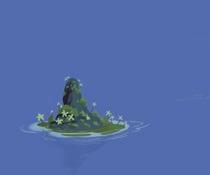
sea!

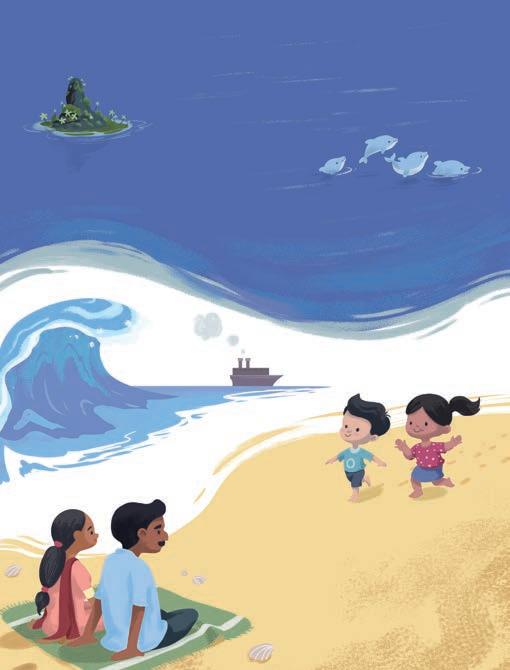





Waves




big and high,
Splash on my face!
Water far and wide, No land in place!


And the coconut tree?


beach,

With golden sand!






Say: . It
Hello, children! In the last class, we heard a rhyme called The Places Where I Go is about a river that tells us that it flows and sees mountains, lakes and forests. We also learnt the new words ‘river’, ‘mountains’, ‘lake’ and ‘forest’.
You may play the game ‘Blue or Green?’. You will say some words and the learners have to tell whether it is blue or green. For example: You may say the word river, and the learners will say ‘blue’.

are.
Instruct: Let us start.
Discuss
Does the river flow?
(Yes, the river flows.)

Say: Let us have some fun! I will do some actions or show flash cards and you will tell what they the keywords learnt in the previous class.
2. What are very big?
(The mountains are very big.)
3. Is the lake clean?
(Yes, the lake is clean.)
4. What has many trees?
(The forest has many trees.)



You may rephrase the learners’ responses into complete sentences and ask them to repeat those sentences. For example: The river flows.
Say:
Wonderful! That was fun.
Instruct: Now, look at the pictures on page no. 53 carefully.
Discuss some of these suggested questions while pointing at the pictures.
What do you see in the picture?
(I see children / a ship / water / sand.)
2. How many fish do you see in the water?
(I see four fish.)

3. Have you seen a fish in real life?
(Yes, I have seen a fish. / No, I have not seen a fish.)
4. What are the children doing?
(The children are running / playing.)


Based on the learners’ responses, you may choose to ask a few follow-up questions on the illustrations.
Theme 7







The Big and Deep Sea things that we see in and around it. Now let us begin reading. the rhyme aloud or the purpose of enjoyment and the second read is for the explanation of the rhyme.

You may show a big chart or illustration of the sea and a beach where there are things like fish and a ship in the sea, sandcastles, seashells on the beach, and high waves in the sea. Then, point at each part for the learners while reading the rhyme.
Say:
Say: We will read a rhyme called . It is about the deep sea and the You may choose to read play the Talking Book. The first read is for Now, I will tell you what the rhyme means. required.
Do not forget to point at the pictures while reading or explaining the rhyme. Pause at regular intervals / after each sentence and explain the meaning in the learners’ home language, if required.
You may bring a poster with the image of trees to the class. Also, carry a transparent bottle with
Explain the meaning of the words while reading the poem. Associate the words with the suggested actions and suggestions.


Sl. no. Word Pronunciation

sea see
a large body of water which has water animals in it
waves vayvz low at breaks


act to bring both your hands to the centre near your chest and open them outwards
in a semicircle
water that flows high and act to bring your right hand forward and move it from side to side by curving your hand a little to show waves


1

trees treez and nuts poster
a tall plant that gives us shade, fruits, vegetables point at the illustration of the trees in the
vaw.tuh something drink point at the water in a transparent bottle
.tuhsomething that we drinkpoint at the water in a transparent bottle sand alongside the sea or point at the illustration of a beach in a poster You may pause at the annotations and ask these suggested questions.
beach beech a lake
What is big and deep?
(The sea is big and deep.)
After 2

What are big and high?
(Waves are big and high.)
Note: Refer to the previous page for annotations.
After



(Dolphins and whales swim in the sea.)
(We can build a castle on the beach.)
You may rephrase the learners’ responses into complete sentences and ask them to repeat those sentences with you. For example: The sea is big and deep.
Summarise
Say: In this rhyme, we read about the blue sea and things that we see in and around it.







Explain

the meanings of these keywords in the learners’ home language.
1. Instruct: Do what I do.
Say what I say. Do what I do.
sea is deep.
The sea is blue.
Repeat 5–6 times.
2. Instruct:

Do the action of bringing both your hands to the centre near your chest and opening them outwards
in a semicircle.
Say what I say. Do what I do.
waves are high.

waves are low.
Repeat 5–6 times.
3. Instruct: Say what I say. beach.
I play on the beach 5–6 times.
4. Instruct: Say what I say. give us food.
Trees are green and tall.
Repeat 5–6 times.

Do the action of bringing your right hand forward and moving it from side to side by curving your
hand a little to show waves.

Point at the illustration of a beach in a poster. Point at the illustration of the trees in the poster.

If the learners struggle to repeat the sentences, you may ignore the articles and prepositions in the sentences. For example: I sit on beach / I sit beach. You may avoid this strategy if you feel that the learners are getting proficient in their English speaking.

Ask
the learners, whom you may select randomly, to speak the sentences independently. Now, you will tell me the sentences with these keywords.
Instruct: Tell me the sentence with the word ‘sea’.
Repeat
Say: the process for all the keywords.
If time permits, you may also invite the learners to speak the sentences with the words that were learnt in periods 1 and 2—‘park’, ‘plants’, ‘grass’, ‘flowers’, ‘river’, ‘mountains’, ‘lake’ and ‘forest’.
Say:

Today, we learnt to speak words and sentences related to the sea. We read that we can see waves, dolphins and whales and sandcastles near a sea. We learnt to speak the words ‘trees’, ‘sea’, ‘waves’ and ‘beach’; and use them in sentences.
Homework

E & R
Theme 7


Say: Today, you will tell your parents about the words and the sentences learnt in the class. You will tell them about the words ‘trees’, ‘sea’, ‘waves’ and ‘beach’. You will show the actions or illustrations of these words.


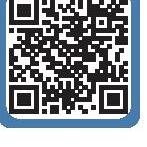





































the keywords learnt in periods 1, 2 and 3.
1. Instruct:
Say what I say. Do what I do.
Do what I do.
flowers are colourful.
The flowers are pink.
Repeat 5–6 times.
2. Instruct:
river is long.


Do the action of joining your hands and opening them with your fingers spread and letting the lower
part of the palms touch each other.
Say what I say. Do what I do.

Repeat 5–6 times.
3. Instruct:
Repeat
river flows. centre to the sides.
Say what I say. Do what I do.
sea is deep.
The sea is blue.
Repeat 5–6 times.
Do the action of bringing your hands forward facing each other and your palms facing downward then waving your hands from the centre
outwards in a semicircle.
Do the action of bringing both your hands to the centre near your chest and opening them the process for all the keywords.


Now, I will call you, one by one, so that you can speak the sentences for the words related to the things that we see in nature.
Invite as
Instruct: Tell
Say: words
Repeat E & R
as many learners as possible to say the sentences. Tell me the sentence with the word ‘flowers’. the process for all the keywords.

You may use the actions, point at the poster or draw the pictures on the board while speaking the words so that the learners are able to associate and recall the sentences or phrases learnt for the words.
You may compliment the learners if they share sentences other than those discussed in the class.






Say:



Now, turn to page no. 56 of your book.
Explain: and sun.
A picture without the colours is given. There are mountains, trees, flowers, clouds
You may ask these suggested questions.


Instruct: grass trees?
You have to colour the picture to show the things that we see in nature. You can colour the mountains brown, sun yellow, clouds and snow white, trees and grass green, sky light blue and flowers of different colours.
What is the colour of the trees?
(The colour of the trees is green.)
2.
Which colour will you use for the flowers?
(I will use yellow / pink / red / orange.)
3. What is yellow in colour?
(The sun is yellow.)

4. What will you colour white?
(I will colour the clouds white.)
I
Say: we see in nature.




In this chapter, we learnt to speak words, phrases and sentences related to the things








As a part of the theme, learners will:
• learn to talk about different seasons.


• learn to say some keywords, phrases and sentences related to seasons.









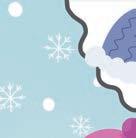

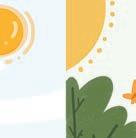
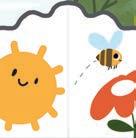
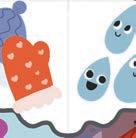

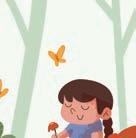
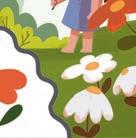









Say: Hello, children. Today, you will listen to the story— pointing

Instruct: Look at the picture on page no. 57 carefully. Discuss some of these suggested questions while pointing at the pictures.
Do you see the sun in the picture? Point at the picture.
(Yes, I see the sun.)
Are you wearing a cap today?
2. (Yes, I am wearing a cap. / No, I am not wearing a cap.)
(Yes, I am wearing a cap. / No, I am not wearing a cap.) Have you seen an umbrella?
3. (Yes, I have seen an umbrella. / No, I have not seen an umbrella.)

(It is red in colour.) Was it raining yesterday?


4. What is the colour of the umbrella in the picture?
(Yes, it was raining. / No, it was not raining.)



Based on the learners’ responses, you may choose to ask a few follow-up questions on the cover page.



Say:
Fantastic! Now, we will read a story called read the story aloud or play the . The first read is for the Now, I will tell you what the story means.
Do not forget to point at the pictures while reading or explaining the story. Pause at regular intervals and explain the meaning in the learners’ home language, if required.


Say: Heera in a Magical Land. It is about a horse, Heera. He lives in a magical land. He loves all the seasons. Now, let us begin reading. You may choose to Talking Book purpose of enjoyment and the second read is for the explanation of the story.




10 mins











seasons!
In a magical land, there lives a big, brown horse, Heera. He loves all
spring summer


season, flowers look bright and colourful. The butterflies dance all around. Heera runs after them.
season comes. The sun shines bright in the sky. Heera wears his hat and a pair of sunglasses. He sips coconut water and bathes in the streams.








the meaning of the words while reading the story. Associate the words with the suggested actions or suggestion.


Sl. no. Word Pronunciation Meaning
see.znz
spring spring

the different times of the year
the season when flowers grow

Sl. no.WordPronunciationMeaning Action / Suggestion
show flash cards of different seasons
act to join your fingers and thumbs and then open and close them to show flowers


summer suh
.muh
the season when the sun shines bright and it is hot
rainy rayn.ee the season when drops of water pour from the sky
winter win.tuh the season when it is cold and we wear warm clothes
You may pause at the annotations and ask these suggested questions.


act to fold your elbows and bring your hands near your neck and shake them to show fanning act to spread fingers of both your hands, wiggle your fingers and bring your hands up and down act to rub your hands on your opposite arms to show that you are feeling cold


What do butterflies do in spring?
(The butterflies dance all around.)
In which season does the sun shine bright?
(The sun shines bright in summer.)
In which season do big drops of rain fall from the sky?
(In rainy season, big drops of rain fall from the sky.)

In which season does the air get chilly?
(In winter, the air gets chilly.)
Refer to the next page for annotations 3 and 4.






In the story, we read about Heera who likes all the seasons like spring, summer, rainy




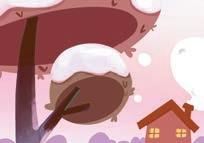
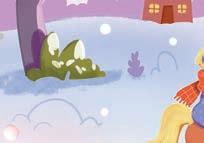





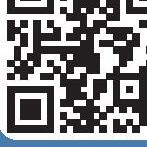



Soon after, big drops of rain fall from the cloudy sky. The season is here! The leaves turn green.

rainy winter
Heera wears his warmest coat and a woollen cap. He builds a snowman and drinks hot milk.

Heera wears his raincoat and opens his umbrella. He plays in the rain. season comes. The air gets chilly. The mountains








Explain

the meanings of these keywords in the learners’ home language.
1. Instruct: Say what I say. seasons are beautiful.
I like all seasons.
Repeat 5–6 times.
2. Instruct: Say
Say what I say. Do what I do.

Show flash cards of different seasons.
Repeat 5–6 times.
3. Instruct: are hot.
Butterflies dance in spring

Say what I say. Do what I do.
4. Instruct: is cold.
spring. Do the action of joining your fingers and thumbs and then opening and closing them to show flowers.

shaking them to show fanning. Repeat 5–6 times.
Say what I say. Do what I do.
Repeat 5–6 times.
Do the action of folding your elbows and bringing your hands near your neck and summers
arms to show it is cold. I wear a cap in winter

Do the action of rubbing your hands on the opposite

If the learners struggle to repeat the sentences, you may ignore the articles and prepositions in the sentences. For example: Flowers grow spring. You may avoid this strategy if you feel that the learners are getting proficient in their English speaking.

Ask learners,
the learners, whom you may select randomly, to speak the sentences independently.
Instruct:
Repeat
Say: Now, you will tell me the sentences with these keywords. Tell me the sentence with the word ‘seasons’. the process for all the keywords.

You may encourage the learners to speak the sentences with actions. You may do the actions or show flash cards and ask the learners what you are doing. For example: Act to join your fingers and thumbs and then open and close them to show flowers, and then ask, ‘Which season is it?’
Conclusion
Say:

Today, we learnt to speak words and the sentences on seasons. We talked about different seasons. We learnt to speak the words ‘seasons’, ‘spring’, ‘summers’ and ‘winter’; and use them in sentences.
Homework
Say: Today, you will tell your parents about the words and the sentences that you learnt in the class. You will tell them about the words ‘seasons’, ‘spring’, ‘summers’ and ‘winter’. You may show the illustration in the book or the actions of those words.
Theme 8






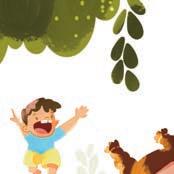



Winter
In the blanket Scarves woollen

days are





warm and bright,
We play outside, day and night.
Cotton clothes we wear in the sun, Go for a swim! Wow, so much fun!


chills us night and day, , we sleep away!
, and gloves so thick, Wear them now, or you’ll fall sick.

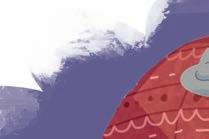
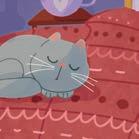



Say:



Greetings, children! In the last class, we heard a story called Heera in a Magical Land It was about a horse called Heera. We heard that he likes all the seasons. We also learnt the words ‘seasons’, ‘spring’, ‘summer’ and ‘winter’.
You can play the game ‘Summer and Winter’. You may say some words and the learners will tell in which season they use or see this. For example: You may say ‘ice cream’ and the learners will say ‘summer’.


what they are.
Instruct: Let us start.
Discuss
Say: Let us have some fun! I will do some actions or show flash cards and you will say the keywords learnt in the previous class.








Praise the learners if they recall the sentences learnt in period 1. You may rephrase the learners’ responses into complete sentences and ask them to repeat those sentences. For example:
Wonderful! That was fun.
What do you see in the first picture?
(I see a fish. / I see three children. / I see a pond.)
Now, look at the pictures on page no. 60 carefully. some of these suggested questions while pointing at the pictures.
Do you like to play in the water?
2. water?
(Yes, I like to play in the water. / No, I do not like to play in the water.)
3.
What do you see in the second picture?

(I see a cat. / I see a boy sleeping. / I see a cup.)
4.

What is the boy wearing on his head?

Winter is cold.

You may bring a cotton cloth or handkerchief and a woollen cap to make the learners understand the words cotton and woollen.
Based on the learners’ responses, you may choose to ask a few follow-up questions on the illustrations.
Theme 8


 (The boy is wearing a cap.)
(The boy is wearing a cap.)




Say: We will read a rhyme called
You may choose to read play the Talking Book
Say:

Summer and Winter. It is about the seasons—summer and winter. We will read about the two seasons, what we wear and what we do during those seasons. Now, let us begin reading. the rhyme aloud or . The first read is for the purpose of enjoyment and the second read is for the explanation of the rhyme.
Now, I will tell you what the rhyme means. Do not forget to point at the pictures while reading or explaining the rhyme. Pause at regular intervals / after each sentence and explain the meaning in the learners’ home language, if required.

You may read the rhyme in rhythm and with lots of actions to make it interesting for the learners.
Explain suggested actions and suggestions.
10 mins

the meaning of the words while reading the rhyme. Associate the words with the

Sl. no. Word Pronunciation

summer suh.muh
a season in which the sun shines bright and it is too hot
warm wawm together
cotton kaw.tn



act to fold your elbows and bring your hands near your neck and shake them to show fanning a day on which we feel hot and we sweat act to join your palms and rub them something that is white and soft, used to make clothes point at the cotton cloth or handkerchief a season which is cold and we wear sweaters act to rub your hands on the opposite arms to show that you are feeling cold something that we use to cover ourselves when we sleep at night in winter act to hold something in your hands at a distance and then pretend to cover something that is used to make winter clothes point at the woollen cap You may pause at the annotations and ask these suggested questions.

winter win.tuh
blanket blang·kuht yourself with it
woollen wul·uhn
Which days are warm and bright?
(Summer days are warm and bright.)



(We wear cotton clothes in summer.)

What do you do in winter?
(We sleep in the blanket in winter.)
What do you wear in winter?


(I wear woollen scarves and gloves.) Refer to the previous page for annotations.
If the learners respond correctly, you may rephrase their responses into complete sentences and ask them to repeat the sentences. For example: If a learner says ‘summer’, you could rephrase it to, ‘Summer days are warm and bright.’


In this rhyme, we learnt about summer and winter seasons. We also learnt what we wear and what we do in these seasons.





Explain

the meanings of these keywords in the learners’ home language. Say what I say. Do what I do.
1. Instruct: Do what I do. warm. The room is warm
Repeat 5–6 times.
2. Instruct: Say what I say. clothes are soft.


Do the action of joining your palms and rubbing them together. Point at the cotton cloth or handkerchief.
I wear cotton clothes.
Repeat 5–6 times.
3. Instruct: blanket with it. blanket.
Repeat 5–6 times.
4. Instruct: Say what I say. woollen cap. Point at the woollen cap. I wear woollen gloves.
Repeat 5–6 times.


Say what I say. Do what I do. keeps me warm. Do the action of holding something in your hands at a distance and then pretending to cover yourself

You may tell the learners the types of clothes we wear in summer and winter. For example: In winter, we wear caps, gloves, sweaters, boots and socks. In summer, we wear hats, chappals, shorts etc.

Ask
the learners, whom you may select randomly, to speak the sentences independently.
Instruct:
Repeat
Say: Now, you will tell me the sentences with these keywords. Tell me the sentence with the word ‘warm’. the process for all the keywords.

You may praise the learners for speaking confidently and correctly. You may say, ‘Wonderful! You spoke well’, ‘Keep it up! You were clear’ or ‘Fantastic!’. If the learners hesitate, you may prompt them or guide them through actions or point at things.
If time permits, you may also invite the learners to speak the sentences with the words learnt in period 1—‘seasons’, ‘spring’, ‘summers’ and ‘winter’.
Conclusion
Say: Say:
Homework
Today, you will tell your parents about the words and the sentences learnt in the class. You will tell them about the words ‘warm’, ‘cotton’, ‘blanket’ and ‘woollen’.
Theme 8


Today, we learnt to speak words and the sentences on summer and winter. We talked about the things we do or wear in summer and winter. We learnt to speak the words ‘warm’, ‘cotton’, ‘blanket’ and ‘woollen’; and use them in sentences.




See these puddles all around!
Pitter-patter, drip-drop-drip


See the rain hit the ground! day
It gets wet on a rainy
Out in the rain, let us play! , float a boat,
Wear a raincoat
Rain is fun, what do you say?
Drops of rain, fall from the sky
Let us dance—both you and I.






Under the umbrella
Jump in puddles, sing rain songs, , we are dry.



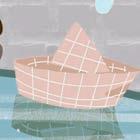
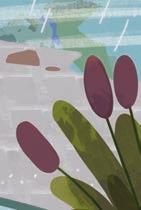




Hello, children! In the last class, we heard a rhyme called about the things we wear and do in summer and winter. We also learnt the new words
Say: Summer and Winter. It was ‘warm’, ‘cotton’, ‘blanket’ and ‘woollen’.


Say: Let us have some fun! I will do some actions or point at the illustrations and you will say what they are.
Instruct:
Let us start.
Discuss the keywords learnt in the previous class.
What is warm?
(The sweater is warm.)
2.
Which clothes are soft?
(Cotton clothes are soft.)
3.
What keeps you warm?
(The blanket keeps me warm.)
4. (I wear a woollen cap.)
What do you wear in winter?



You may rephrase the learners’ responses into complete sentences and ask them to repeat those sentences. For example: The sweater is warm.
Say:
Wonderful! That was fun.
Instruct: Now, look at the pictures on page no. 61 carefully. Discuss some of these suggested questions while pointing at the pictures.
What do you see in the picture?
(I see children / a boat / a frog.)
2.
Is it raining?

(Yes, it is raining.)
3.
Do you like to play in the rain?
(Yes, I like to play in the rain. / No, I do not like to play in the rain.)


Based on the learners’ responses, you may choose to ask a few follow-up questions on the illustrations.







Say: We will read a rhyme called . It is about what we see and do in the rainy season. Now let us begin reading. You may choose to read play the Talking Book. The first read is for
the rhyme aloud or the purpose of enjoyment and the second read is for the explanation of the rhyme.

You may read the rhyme with voice modulation, hand gestures and in rhythm to make it interesting for the learners.
Say:
Now, I will tell you what the rhyme means. required.
Do not forget to point at the pictures while reading or explaining the rhyme. Pause at regular intervals / after each sentence and explain the meaning in the learners’ home language, if required.
Explain the meaning of the words while reading the poem. Associate the words with the suggested actions and suggestion.



Sl. no. Word Pronunciation Meaning
Sl. no.WordPronunciationMeaning Action / Suggestion something that has act to shake both your hands as if drying the a season in which water drops from sky act to spread the fingers of both your hands, wiggle your fingers and bring your hands up something that you wear to protect yourself from the rain show a flash card of a raincoat something that gives you shade in the rainy act to join your hands above your head and form a semicircle to show an umbrella
raincoat rayn.kote

wet vet water on it water from the hands rainy rayn.ee and down

1

umbrella uhm.breh.luh season
You may pause at the annotations and ask these suggested questions.
What can we see all around?
(We can see puddles all around.)
2
What happens on a rainy day?
(It gets wet on a rainy day.)
Note: Refer to the previous page for annotations.



What do we wear on a rainy day?
(We wear a raincoat on a rainy day.)


What keeps us dry in the rainy season?
You may ask the learners which season it is. You may also ask them why they think it is a particular season. After their responses, you can tell them which season it is and how we know it.
You may rephrase the learners’ responses into complete sentences and ask them to repeat those sentences with you. For example: It gets wet on a rainy day.
Summarise
Say:
In this rhyme, we read about the rainy season and what we do in it.





Explain

the meanings of these keywords in the learners’ home language.
1. Instruct: Do what I do.
Say what I say. Do what I do.
rainy season.
I play in the rainy season.
Repeat 5–6 times.
2. Instruct:
wet in the rain.
My hands are wet
Repeat 5–6 times.
3. Instruct: Say what I say. raincoat
My raincoat is wet.
Repeat 5–6 times.
4. Instruct: umbrella
Do the action of spreading the fingers of both your hands, wiggling your fingers and bringing your
hands up and down.
Say what I say. Do what I do.


I have a small umbrella.
Repeat 5–6 times.

Do the action of shaking both your hands as if

Show a flash card of a raincoat.
Say what I say. Do what I do.
Do the action of joining your hands above your head and forming a semicircle to show an umbrella.



Ask
the learners, whom you may select randomly, to speak the sentences independently.
Instruct:
Repeat
Say: Now, you will tell me the sentences with these keywords. Tell me the sentence with the word ‘wet’. the process for all the keywords.


Say:
Homework
Say: Today, you will tell your parents about the words and the sentences learnt in the class. You will tell them about the words ‘rainy’, ‘wet’, ‘raincoat’ and ‘umbrella’.
Theme 8


Today, we learnt to speak words and sentences on the rainy season. We get wet, float boats, wear a raincoat and jump in the puddles. We learnt to speak the words ‘rainy’, ‘wet’, ‘raincoat’ and ‘umbrella’; and use them in sentences.









Cotton clothes are soft.

The blanket keeps me warm.

I wear a woollen cap. I get wet in the rain.





I have a yellow raincoat.



I have a red umbrella. • XPRE SS
Seasons

















Discuss

the keywords learnt in periods 1, 2 and 3.
Say what I say. Do what I do.
1. Instruct: Do what I do. are hot.
The sun shines bright in summers.
Repeat 5–6 times.
2. Instruct: warm.
Say what I say. Do what I do.
The room is warm.
Repeat 5–6 times.
3. Instruct:

I play in the rainy season. 5–6 times.

Do the action of folding your elbows and bringing your hands near your neck and shaking them to show fanning.
Do the action of joining your palms and rubbing
them together.
Say what I say. Do what I do.
rainy season. up and down.
the process for all the keywords.



Do the action of spreading the fingers of both your hands, wiggling your fingers and bringing your hands
Now, I will call you, one by one, so that you can speak the sentences for the words
Say: words related to seasons.
Invite as
as many learners as possible to say the sentences.
Instruct: Tell
Repeat E & R
Tell me the sentence with the word ‘warm’. the process for all the keywords.

You may use the actions or show flash cards while speaking the words so that the learners are able to associate and recall the sentences or phrases learnt for the words.
You may appreciate the learners if they share sentences other than those discussed in the class.







Say:



Now, turn to page no. 64 of your book.
Explain:
Pictures of summer, rainy and winter seasons are given. Some pictures are given without the colours. You have to choose the correct picture of that season and colour it. For example: The first season is summer. The third picture of the girl shows that she is wearing summer clothes. So, colour it.
Instruct:
Choose the correct picture of the season. Then, colour it. The clothes of the children will help you choose the correct season.


You may ask these suggested questions.

In which season do we use an umbrella?
(We use an umbrella in the rainy season.)


2. Do you wear
Do you wear a raincoat in the rainy season?
(Yes, I wear raincoat in the rainy season.)
3. a in
In which season do you wear a woollen cap?
(I wear a woollen cap in the winter season.)
What else do you wear in the winter season?
4. the summer season?
(I also wear a jacket / sweater / boots / gloves in the winter season.)

Do you eat ice cream in the summer season?
(Yes, I eat ice cream in the summer season.)



Say: seasons.

In this chapter, we learnt to speak words, phrases and sentences related to different seasons. We also learnt what we do and wear in spring, summer, rainy and winter







As a part of the theme, learners will:
• learn to talk about India.
• learn to say some keywords, phrases and sentences related to India.








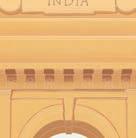










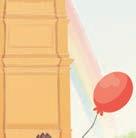
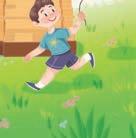


Say:



Good morning, little stars. Today, you will listen to the story—Parts of India
You can use polite greetings like ‘Bright Morning!’, ‘How are you?’, ‘How are you feeling today?’ or themebased questions like ‘Have you seen the flag of India?’, ‘Have you been to a cold place?’ to begin the class.
Instruct:
Discuss while pointing at the pictures.

Look at the picture on page no. 65 carefully. some of these suggested questions while pointing at the pictures.


What do you see in the picture?
(I see some children / a balloon / a rainbow.)
2. (The children are playing.)
What are the children doing?
3.
Does the building in the picture look like a gate?
(Yes, the building looks like a gate.)
4.
Have you ever been to the India Gate?

Name the places that you went to in India.
(I went to New Delhi / Jaipur / Mumbai / Shimla / Pune.)



(Yes, I have been to the India Gate. / No, I have not been to the India Gate.)

Based on the learners’ responses, you may choose to ask a few follow-up questions on the


I went to New Delhi.


Say: It is great to know you have seen so many places! Now, we will read a story called Parts of India. It is about the students sharing where they went for their summer vacation. Now, let us begin reading.
You may choose to Talking Book purpose of enjoyment and the second read is for the explanation of the story.
Say: Now, I will tell you what the story means.

read the story aloud or play the . The first read is for the

10 mins went
Do not forget to point at the pictures while reading or explaining the story. Pause at regular intervals and explain the meaning in the learners’ home language, if required.

You may carry a physical map of India and the world to the class.










The summer holidays are over. All the students are happy to come back to school. They went to different parts of India for their vacation. They talk about it in the class.

mountains beautiful!” says Asif happily.



“I went to Jammu and Kashmir. The there were so big! They were covered with white snow! The Dal Lake was blue and Tina says, “I went to Jaisalmer. The was so hot. I enjoyed riding on the camel. I also ate
desert dal-bati-churma!”
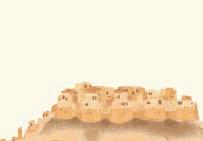
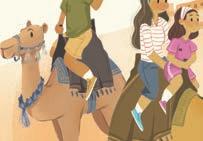











the meaning of the words while reading the story. Associate the words with the suggested actions and suggestions.

Sl. no. Word Pronunciation Meaning
1 in.dee·aa the country point
.tnz
2 mountains mown hills that are very high and have many rocks



Sl. no.WordPronunciationMeaning Action / Suggestion
.dee·aathe name of our countrypoint at the physical map of India
act to bring your hands forward and join the fingertips of both your hands and open the palms from below
3 desert de.zurt a place where there is a lot of sand and is usually hot
4 sea see a large body of water which has water animals in it and ships sail on it
5 beaches beech sand along the side of a sea or a lake
.uhz
6 country kuhn a large area where people live together under the same
.tree government



point at the illustration of the desert in the poster
act to bring both your hands to the centre near your chest and open them outwards in a semicircle
point at the illustration of a beach in the poster
show the world map and point to different countries including India
7 forests faw a place where many trees grow and wild animals live
.ruhsts

After After
Where did Asif see big mountains? (Asif saw big mountains in Jammu and
Kashmir.)

On which animal did Tina enjoy riding? (Tina enjoyed riding on the camel.)


point at the illustration of forests with trees and animals
You may pause at the annotations and ask these suggested questions.


What did Joseph see for the first time? (Joseph saw the sea for the first time.)
Where did Manju see lots of rhinos? (Manju saw lots of rhinos in Assam.)

Note: Refer to the next page for annotations 3 and 4.
In the story, we read about the different places that the students visited in their
• India






“I went to Kerala with my family. I saw the were so much fun,” says Joseph.
sea for the first time! The beaches



“Our country and forests

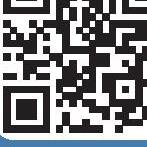

“My turn! I went to Assam,” says Manju. “My grandparents live there. We went to a national park. It had lots of rhinos.” has everything—mountains, deserts, seas, beaches ! Next time, I will go to a new place,” says Asif.

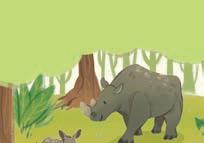

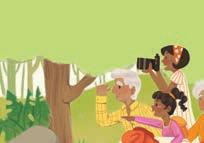










Explain

the meanings of these keywords in the learners’ home language.
1. Instruct:
Say what I say. Do what I do.
mountains
The mountains
Repeat 5–6 times.
2. Instruct: Say what I say. desert is very hot.


are very big. Do the action of bringing your hands forward and joining the fingertips of both your hands and opening the palms from below. are very high.
A desert has sand.
Repeat 5–6 times.
Say what I say. Do what I do.
3. Instruct: sea. a semicircle.
The sea has many fishes.
Repeat 5–6 times.
Point at the illustration of the desert in the poster.

Do the action of bringing both your hands at the centre near your chest and opening them outwards in
4. Instruct: Say what I say. forests animals.
The animals live in the .
have many trees. Point at the illustration of forests with trees and forests
Repeat 5–6 times.




Ask learners,
Say:
the learners, whom you may select randomly, to speak the sentences independently. Now, you will tell me the sentences with these keywords.
Instruct: Tell me the sentence with the word ‘mountains’.
Repeat
the process for all the keywords.
Say:

Today, we learnt to speak words and the sentences about different places in India. We talked about mountains, forests, seas, beaches and deserts. We learnt to speak the words ‘mountains’, ‘desert’, ‘sea’ and ‘forests’; and use them in sentences.
Homework

E & R

Say: Today, you will tell your parents about the words and the sentences that you learnt in the class. You will tell them about the words ‘mountains’, ‘desert’, ‘sea’ and ‘forests’.
Theme 9
• India








Lotus, Pink and bright.
Our national flower,
Is a lovely sight!



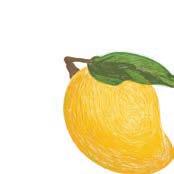


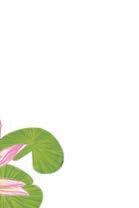
Look at the Tiger,

Our national animal, Is orange and gold.






Look at the Have a slice. Our national fruit, Tastes so nice.
Mango,

Peacock!
Look at the Its dance, so grand. Our national bird, Most beautiful on the land.



Say:



Hello, children! In the last class, we heard a story called different places in India and the various things that the students saw there. For example: Asif saw the mountains in Jammu and Kashmir. We also learnt the words ‘mountains’,
Parts of India. It was about in ‘desert’, ‘sea’ and ‘forests’.


Say: Let us have some fun! I will do some actions or point at the illustrations and you will say what they are.
Instruct:
Let us start.
Discuss the keywords learnt in the previous class.
What are very big?
(The mountains are very big.)
2.
Which place is very hot?
(A desert is very hot.)
3.
Where do ships move?
(Ships move in the sea.)
What do forests have?
4. (The forests have many trees.)


A desert is very hot. If the learners respond in complete sentences, you may


Say:
Wonderful! That was fun.
Instruct: Now, look at the pictures on page no. 68 carefully.
Discuss some of these suggested questions while pointing at the pictures.
What do you see in the picture?
(I see a mango / flower / peacock / tiger.)
Have you seen a tiger?
2. (Yes, I have seen a tiger. / No, I have not seen a tiger.)
3.
Which flower is given in the picture?
(The flower is lotus.)
Have you seen a peacock dancing?


4. (Yes, I have seen a peacock dancing. / No, I have not seen a peacock dancing.)
Based on the learners’ responses, you may choose to ask a few follow-up questions on the illustrations.
Theme 9
• India







Say: We will read a rhyme called India. Now, let us begin reading. You may choose to read play the Talking Book for
Symbols of India. It is about the national symbols of the rhyme aloud or . The first read is for the purpose of enjoyment and the second read is for the explanation of the rhyme.
Now, I will tell you what the rhyme means.

Do not forget to point at the pictures while reading or explaining the rhyme. Pause at regular intervals / after each sentence and explain the meaning in the learners’ home language, if required.
Say: actions

You may read the rhyme with voice modulation, hand gestures and in rhythm to make it interesting for the learners.
10 mins
Explain the meaning of the words while reading the rhyme. Associate the words with the suggested actions and suggestion.


Sl. no. Word Pronunciation Meaning

Note:
lotus loh.tuhs hands mango mang.goh card of mango tiger tai.guh in colour
peacock pee.kawk



a flower that is pink in colour, has many petals and grows in water act to curve your palms and then join your fingers and thumbs of both the a fruit that is oval and yellow or orange in colour you may bring this fruit or show a flash an animal that has stripes on it and is usually orange act to form claws with both your hands and roar a little to show the tiger a bird that has colourful wings and dances in the rain act to raise your hands above your head with fingers spread, bring down your hands slowly sideways by shaking them
You may pause at the annotations and ask these suggested questions.
Refer to the previous page for annotations.

Which is the national bird of India?
(Peacock is the national bird of India.)
If the learners respond correctly, you may rephrase their responses into complete sentences and ask them to repeat the sentences. For example: If a learner says ‘lotus’, you could rephrase it to ‘Lotus is the national flower of India.’
Summarise



Say: In this rhyme, we read about the national flower, fruit, animal and bird of India.




Explain

the meanings of these keywords in the learners’ home language.
Say what I say. Do what I do.
1. Instruct: Do what I do. is pink.
Lotus is a flower.
Repeat 5–6 times.
Do the action of curving your palms and then joining your fingers and thumbs of both the hands.
2. Instruct: Say what I say.
mango Show the real fruit or a flash card of
Mango is yellow in colour.
Repeat 5–6 times.
3. Instruct:


mango to the class.
Say what I say. Do what I do.



tiger roars.
The tiger has stripes.
Repeat 5–6 times.
4. Instruct:
Do the action of forming claws with both your hands and roaring a little to show the tiger.
Say what I say. Do what I do.
peacock
dances in the rain.
The peacock
is blue and green.
Repeat 5–6 times.

Do the action of raising your hands above your head with fingers spread, bringing down your hands slowly sideways by shaking them.
Ask
Say:

the learners, whom you may select randomly, to speak the sentences independently. Now, you will tell me the sentences with these keywords.
Instruct: Tell Repeat
Tell me the sentence with the word ‘lotus’. the process for all the keywords.
You may praise the learners for speaking confidently and correctly. You may say, ‘Very good!’, ‘You spoke well!’ or ‘Fabulous!’. If the learners hesitate, you may prompt them or guide them through actions or flash cards.
If time permits, you may also invite the learners to speak the sentences with the words learnt in period 1—‘mountains’, ‘desert’, ‘sea’ and ‘forests’.


Conclusion 2 mins
Today, we learnt to speak words and the sentences on national things of India. We talked about the national flower, national fruit, national animal and national bird of India. We learnt to speak the words ‘lotus’, ‘mango’, ‘tiger’ and ‘peacock’; and use them in
Homework
Say:
Say: things use sentences.

Today, you will tell your parents about the words and the sentences learnt in the class. You will tell them about the words ‘lotus’, ‘mango’, ‘tiger’ and ‘peacock’. You may point and show the illustrations in the book.
E & R • India




Let’s sing about it,


flag, Me and you.



Our national flag, Flies so high. It is of tricolour. Do you know why?
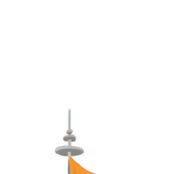


It has three colours,

Saffron, white and green.
Also a blue wheel, Which is in between.

Our flag stands

We salute it!







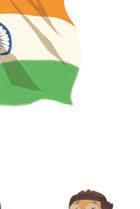





Hello, children! In the last class, we heard a rhyme called Symbols of India about the national symbols of India. We also learnt the new words ‘lotus’, ‘mango’, ‘tiger’
Say: . It was and ‘peacock’.
You may include some exercises or actions, between the class, to keep the learners active and engaged.
Say:
Let us have some fun! I will do some actions or show flash cards and you will say what they are.
Instruct: Let us start.
Discuss



the keywords learnt in the previous class.
Which flower is pink?
(Lotus is pink.)
2. Do you like to eat mango? (Yes, I like to eat mango.)
3. Which animal roars? (The tiger roars.)

Which bird dances in the rain?
4. rain?

(The peacock dances in the rain.)





You may rephrase the learners’ responses into complete sentences and ask them to repeat those Lotus is pink.
Wonderful! That was fun.
Now, look at the pictures on page no. 69 carefully. some of these suggested questions while pointing at the pictures.
What do you see in the picture?
(I see people / children / a flag / India’s flag.)
2. (There are three children.)
Let us do some counting. How many children are there?
3.
How many colours are there in the flag?
(There are three colours in the flag.)



4. of
What is the colour of the round wheel in the centre of the flag?
(The colour of the round wheel in the centre of the flag is blue.)
Based on the learners’ responses, you may choose to ask a few follow-up questions on
• India







Say: We will read a rhyme called . It is about the national flag of India, the three it
You may choose to read play the Talking Book. The first read is for
India’s Flag colours it has and the blue wheel in between. Now let us begin reading. the rhyme aloud or the purpose of enjoyment and the second read is for the explanation of the rhyme.

You may read the rhyme with voice modulation, hand gestures and in tune to make it interesting for the learners.
Say:
Now, I will tell you what the rhyme means. required.
Do not forget to point at the pictures while reading or explaining the rhyme. Pause at regular intervals / after each sentence and explain the meaning in the learners’ home language, if required.

Explain the meaning of the words while reading the poem. Associate the words with the suggested actions and suggestion.


Sl. no. Word Pronunciation Meaning flag flag national nash.nuhl country salute suh.loot

Have you seen India’s flag?

After 2



a piece of cloth that has the symbol of a country on it act to hold an imaginary stand of the flag in your hand and move your hand left to right
something that belongs to the show flash cards of all the national symbols of India
You may pause at the annotations and ask these suggested questions.
(Yes, I have seen India’s flag. / No, I have not seen India’s flag.)
How many colours does our national flag have?
(Our national flag has three colours.)
Note: Refer to the previous page for annotations.
Summarise
to show respect to a particular thing act to touch the tip of your right hand to your head, palms facing outward


What are the three colours of the flag?
(The three colours are saffron, white and


We salute our flag.


What do we do when we see our flag?
(We salute our flag.)


You may rephrase the learners’ responses into complete sentences and ask them to repeat those sentences with you. For example:


Say: In this rhyme, we read about the national flag of India, the colours it has and what we do when we see it.




Explain

1. Instruct: Do what I do.
the meanings of these keywords in the learners’ home language. Say what I say. Do what I do.
flag
The Indian flag
Repeat 5–6 times.
2. Instruct: Say what I say.
India.

Do the action of holding an imaginary stand of the flag in your hand and moving your hand left has three colours.
to right.

Point at the physical map of India. I love India
Repeat 5–6 times.
3. Instruct: Say what I say.
beaches and seashells in the poster. I like to play on beaches.
Repeat 5–6 times.
4. Instruct: Say what I say. country
India is my country.
Repeat 5–6 times.


Point at the illustration of a beach with a sandcastle
Point at different countries on the world map.


Ask

Say:
the learners, whom you may select randomly, to speak the sentences independently. Now, you will tell me the sentences with these keywords.
Instruct: Tell me the sentence with the word ‘India’.
Repeat
the process for all the keywords.
If time permits, you may also invite the learners to speak the sentences with the words that were learnt in periods 1 and 2—‘mountains’, ‘desert’, ‘sea’, ‘forests’, ‘lotus’, ‘mango’, ‘tiger’ and ‘peacock’.
Conclusion
Say:

Today, we learnt to speak words and sentences on the national flag. It has three colours and a blue wheel in between. We learnt to speak the words ‘India’, ‘beaches’, ‘country’ and ‘flag’; and use them in sentences.
Homework

E & R
Say: Today, you will tell your parents about the words and the sentences learnt in the class. You will tell them about the words ‘India’, ‘beaches’, ‘country’ and ‘flag’. You may also ask your parents to show you the national flag of India.
Theme 9
• India







The forests have many trees.












Lotus is pink. I like to eat mango. The tiger roars. The peacock dances in the rain. India



















Discuss

the keywords learnt in periods 1, 2 and 3.
1. Instruct:
mountains
Do what I do.
Say what I say. Do what I do. are very big. Do the action of bringing your hands forward and joining the fingertips of both your hands and
The mountains are high.
Repeat 5–6 times.
2. Instruct: is pink.
opening the palms from below.
Say what I say. Do what I do.


Lotus is a flower.
Repeat 5–6 times.
Say what I say. Do what I do.
Do the action of curving your palms and then joining your fingers and thumbs of both the hands.

3. Instruct: flag left to right. The Indian flag colours.
Repeat 5–6 times.
Repeat
the process for all the keywords.
Do the action of holding an imaginary stand of the flag in your hand and moving your hand left has three colours.


Say: words
Now, I will call you, one by one, so that you can speak the sentences for the words related to India.
Invite as
Instruct: Tell
Repeat E & R
as many learners as possible to say the sentences. Tell me the sentence with the word ‘flag’. the process for all the keywords.

You may use the actions or show flash cards while speaking the words so that the learners are able to associate and recall the sentences or phrases learnt for the words.
You may compliment the learners if they share sentences other than those discussed in the class.










Say:
Now, turn to page no. 72 of your book.
Explain: the
Instruct:
Look at the pictures and colour the national symbols of India. You may ask these suggested questions.



Some pictures without colours are given. You have to look at the pictures and colour the national symbols of India. For example: Between the tiger and the elephant, it is the tiger that is our national symbol. So, colour the picture of the tiger.
Which animal is the national animal of India?
(The tiger is the national animal of India.)
2.
Is apple the national fruit of India?
(No, apple is not the national fruit of India.)
3. 4. flower
Which fruit is the national fruit of India?
(The mango is the national fruit of India.)
Which flower is the national flower of India?
(The lotus is the national flower of India.)

Will you colour the sunflower?
(No, I will not colour the sunflower.)
No, not





Say: In this chapter, we learnt to speak words, phrases and sentences related to India. We talked about the places in India, national symbols and the national flag of India.









The Conversations book is a vibrant educational resource tailored for young learners whose native language is not English. Comprising engaging stories and charming poems, this book offers a joyful way to build age-appropriate English listening skills, common vocabulary, and everyday expressions in the language. The activities are teacher-led and are based on the acclaimed ‘Total Physical Response’ (TPR) approach, enabling young learners to practise English speaking and listening skills in a manner that is fun and interactive.


• Activity-based Learning: The book offers joyful and experiential activities that build English communication competencies.
• Texts as per NEP 2020 Themes: The book has exciting and stimulating texts that pave the way for English communication activities.
• Teachers’ Manual: The book is complemented by the Teachers’ Manual that enables teachers to conduct each session effectively.


Uolo partners with K-12 schools to provide technology-based learning programs. We believe pedagogy and technology must come together to deliver scalable learning experiences that generate measurable outcomes. Uolo is trusted by over 10,000 schools across India, South East Asia and the Middle East.




